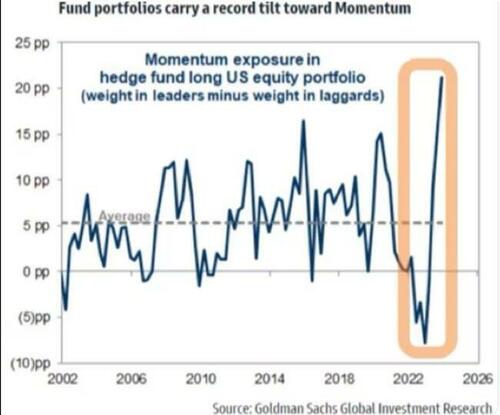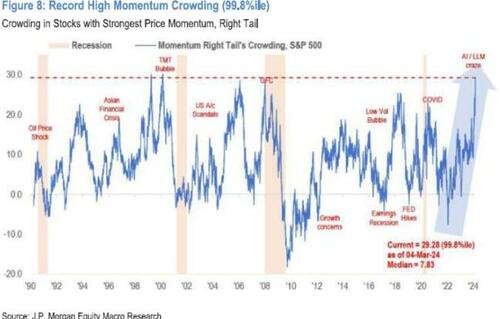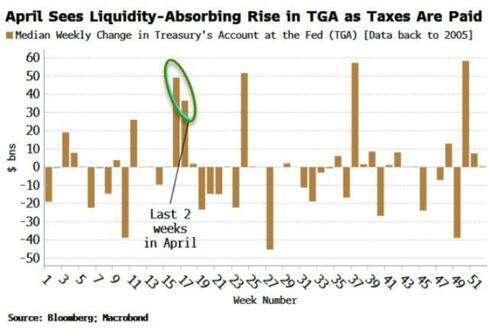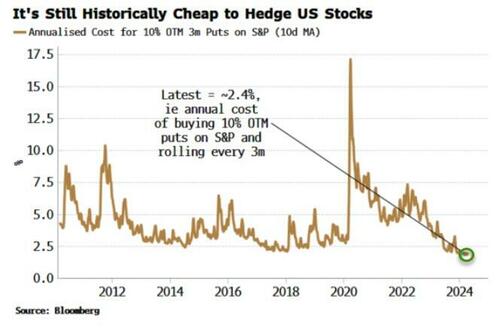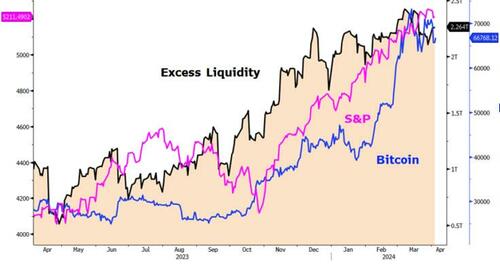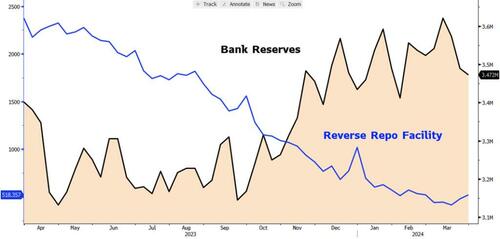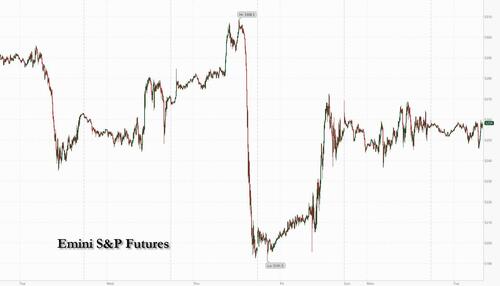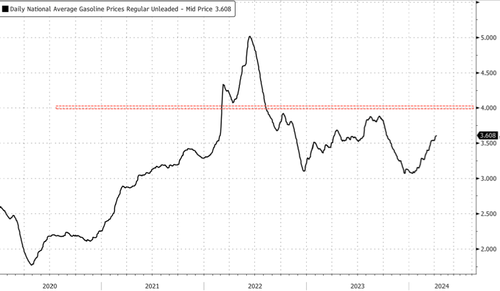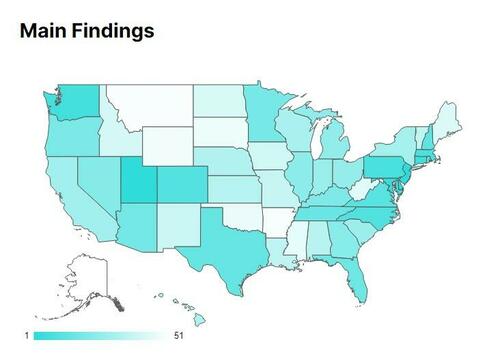Certainly, it is difficult to make the demands of the Gospel understandable to secularized people. But this pastoral difficulty must not lead to compromises with the truth.
Distinction Matter - Subscribed Feeds
-
Site: RT - News
The Jewish state has threatened retaliation against Ankara’s restrictions over the Gaza war
The Turkish government has imposed export restrictions on Israel covering 54 product categories, in response to the Gaza war, the Trade Ministry announced on Tuesday.
Ankara has been one of the fiercest critics of Israel since the conflict with Hamas broke out in October. Protests have been held in Istanbul in recent days demanding a trade ban. Ankara’s decision also follows the Israeli government’s refusal to allow Turkish aid drops into Gaza.
According to Turkish Trade Ministry, the items on the export embargo list – which takes immediate effect – include aluminum, copper, steel, construction materials, machinery, and various chemical products. Türkiye had already stopped sending Israel any goods that could be used for military purposes, the ministry noted.
The restrictions will remain in place until Israel declares a ceasefire in Gaza and allows “the unhindered flow of sufficient humanitarian aid” into the area, the document adds. Israel has been accused by the UN and human rights groups of obstructing the deliveries of aid into Gaza.
Read more Israel summons Turkish envoy after Erdogan’s ‘send Netanyahu to Allah’ remark
Israel summons Turkish envoy after Erdogan’s ‘send Netanyahu to Allah’ remark
In response to the restrictions, the Israeli Foreign Ministry accused Türkiye of “unilaterally” violating bilateral trade deals. Foreign Minister Israel Katz took to X (formerly Twitter) on Tuesday to threaten Ankara with “parallel measures” that will “harm” the Turkish economy. Israel will prepare a list of products it intends to stop buying from Türkiye, he said. Katz also called on the US to halt investments in the country and impose sanctions on Ankara.
The trade dispute follows a diplomatic row between the two nations’ leaders. Turkish President Recep Tayyip Erdogan has repeatedly compared the Israeli Prime Minister Benjamin Netanyahu to Adolf Hitler and accused Israel of committing “genocide” against the Palestinians. Israel, meanwhile, has claimed that the Turkish president ranks among the worst anti-Semites in history, due to his stance on the conflict and support for Hamas.
Israel declared war on Hamas in October in response to a deadly raid staged by the militant group, in which at least 1,200 people were killed and more than 200 taken hostage. The retaliatory bombing of Gaza and ground operation has caused the deaths of at least 33,000 people, according to the territory’s Health Ministry.
-
Site: LifeNews
Two years ago, pro-life advocates made a horrific discovery when they opened boxes of medical waste from a late-term abortion facility in Washington, D.C.
Inside were the bodies of 115 aborted babies, including five who appeared to be nearly full term and possibly victims of illegal partial-birth abortions or infanticide.
However, D.C. officials seemingly have done nothing to investigate the horrific discovery despite repeated calls from U.S. Congressional leaders and pro-life advocates. Undercover investigations exposing other unethical and potentially illegal activity by abortionist Cesare Santangelo and his Washington Surgi-Clinic appear to have gone ignored as well.
Now, Pro-life groups are urging the House Judiciary Committee and pro-life Chairman Jim Jordan to hold a thorough hearing while continuing the fight for justice for the five babies. The babies are five children whose lives were reportedly brutally ended at the clinic of a notorious late-term abortionist in Washington D.C.
The letter appears below:
Dear Chairman Jordan,
We are grateful for the timely intervention of House Judiciary Subcommittee Chairmen Chip Roy and Andy Biggs on behalf of the D.C. Five this February. The D.C. Five—ngel, Christopher X, Harriet, Holly, and Phoenix—are five children whose lives were reportedly brutally ended at the clinic of notorious late-term abortionist Dr. Cesare Santangelo in Washington D.C. The Biden administration has so far refused to investigate the deaths of these children, despite evidence of potential federal crimes, and instead greenlit discarding their bodies. Dozens of members of Congress stepped in to block the D.C. Medical Examiner from disposing of their remains prematurely. We urge the House Judiciary Committee to investigate Cesare Santangelo’s practices and to demand justice for the Five.
The bodies of the D.C. Five were discovered by pro-life activists two years ago, on March 25, 2022, outside of the Washington Surgi-Clinic, only five blocks from the White House. The lives of these five children were ended late in pregnancy. Although the activists who found them asked the police to investigate, and despite repeated requests from members of Congress and the public, to date, no autopsies or investigations have occurred. In the meantime, several Ob-Gyns including former abortionists have reviewed many pictures of the remains and determined the likely gestational ages of these babies and the probable procedures used by which their lives were ended.
REACH PRO-LIFE PEOPLE WORLDWIDE! Advertise with LifeNews to reach hundreds of thousands of pro-life readers every week. Contact us today.
While these experts believe ngel and Holly may have been killed via the tragically legal procedure of dismemberment abortion, several federal laws – including the Partial Birth Abortion Ban Act (18 USC § 1531) and/or the Born Alive Infants Protection Act (1 USC § 8) allegedly may have been violated in conjunction with the deaths of the other three.[1] These are the estimated gestational ages of the babies who were potential victims of federal crimes:
- Harriet (possible partial-birth abortion): 28-29 weeks
- Christopher X (possibly born-alive): 32-33 weeks
- Phoenix (possibly born-alive): 25-26 weeks
Members of Congress and of the public have continued calling on the Department of Justice and the mayor of the District of Columbia to investigate Cesare Santangelo and the deaths of the Five. Nonetheless, no investigation has occurred, and there is evidence indicating they have no intention to investigate.
Instead of investigating Cesare Santangelo and his practice for these alleged federal crimes, the Biden administration submitted a budget that would fund abortion for any reason at any stage of development in D.C. They have turned a blind eye to these tragic deaths and alleged crimes and instead proposed sending more business to abortion clinics in the District—including the Washington Surgi-Clinic—with taxpayer dollars.
Because the District of Columbia falls under federal jurisdiction and federal crimes may have been committed by Cesare Santangelo, we urge the House Judiciary Committee to hold a thorough hearing into the D.C. Five. These five children should be toddlers now, but instead are lying in a morgue awaiting the justice that continues to be denied to them. Cesare Santangelo must be investigated. We demand Justice for the Five.
Sincerely,
Susan B. Anthony Pro-Life America Progressive Anti-Abortion Uprising
Thomas More Society Americans United for Life
American Association of Prolife Obstetricians Concerned Women for America
and Gynecologists Legislative Action CommitteeFamily Policy Alliance Family Research Council
March for Life Action National Right to Life
Students for Life Action The Abortion Survivors Network
Live Action CatholicVote
Center for Family and Human Rights Eagle Forum
Ethics and Public Policy Center The Center for Medical Progress
American Cornerstone Institute The FAMiLY Leader
Choose-Life America Citizens for a Pro-Life Society
Coalition for Jewish Values Good Counsel
Human Coalition Action Human Life Alliance
Human Life of Washington Kentucky Right to Life
Liberty Counsel Liberty Counsel Action
Life Issues Institute Life Legal Defense Foundation
Life Matters TV and Media, Inc. LifeNews.com
Louisiana Family Forum NC Values Coalition
New Mexico Alliance for Life Ohio Right to Life
Operation Rescue Priests for Life
Pro-Life Action League Protect Life Michigan
Sanctuary Cities for the Unborn Secular Pro-Life
South Dakota Right to Life Speakhope.net
Stand True The White Rose Resistance
Wisconsin Family Action Wyoming Family Alliance
Images of the brutalized remains of these children have been circulated across the globe and appear to be evidence of federal crimes including violations of the Partial Birth Abortion Ban Act and the Born Alive Infant Protection Act.
Earlier this year, the Biden administration ordered destruction of the babies’ bodies — which could permanently destroy the criminal evidence. But pro-life attorneys were able to stop it.
Caroline Taylor Smith, Executive Director of PAAU, the Progressive Anti-Abortion Uprising, says this day has long been feared and she told LifeNews that destruction of their bodies could forever deny them justice.
“We suspected that Biden’s DOJ would attempt to sweep this evidence under the rug. This is yet another step in the coordinated effort to protect Big Abortion and Caesare Santangelo’s horrific crimes. These children cry out for justice and we won’t stop fighting for them,” she told LifeNews.
In March 2022, Terrisa Bukovinac and Lauren Handy found the bodies of the five late-term aborted babies and more than 100 first-trimester aborted babies in boxes that they received from a truck driver who was collecting medical waste from Santangelo’s abortion facility.
Last year, dozens of U.S. Congressional leaders joined pro-life advocates in demanding a federal investigation into Santangelo’s practice. However, some expressed doubts that the U.S. Department of Justice will do anything because pro-abortion Democrat officials with the Biden administration lead the agency.

The post 50 Pro-Life Groups Call for Investigation of Five Babies Killed in Infanticides or Abortions appeared first on LifeNews.com.
-
Site: RT - News
The billionaire suggested the southern border crisis could eventually lead to a 9/11-scale tragedy
Elon Musk has warned that a terrorist attack on the scale of September 11, 2001 could take place in the US unless the crisis at the southern border and the uncontrolled influx of migrants is addressed.
The Tesla and SpaceX CEO made the remarks in response to an X post by former Republican presidential candidate and businessman Vivek Ramaswamy, who called for mass deportations and the sealing of the US-Mexico border.
“Even if only 0.1% of illegal aliens who’ve crossed our border have hostile intentions, that’s tens of thousands of would-be attackers,” Ramaswamy pointed out, suggesting that unless special attention is paid to the issue, “we’re paving the way for another 9/11-scale tragedy.”
Musk replied, saying it is “only a matter of time” before such a disaster unfolds.
Previously, the billionaire argued that the ability of illegal migrants to cross the US-Mexico border and claim asylum without showing any identification “has turned America into a refuge for the world’s worst criminals.” His claim followed reports that Venezuela’s homicide rate had dropped to its lowest in 22 years – with some suggesting this was due to Venezuelan gangs moving to the US.
Read more Elon Musk accuses Democrats of ‘importing voters’
Elon Musk accuses Democrats of ‘importing voters’
Meanwhile, a Politico report published last month suggested that US President Joe Biden was considering offering permanent residency to millions of illegal immigrants. Musk responded to the news by accusing the US Democratic party of intentionally opening up the southern border in order to “import voters.”
There are currently thought to be around 10.5 million illegal immigrants living in the US, according to data compiled by Pew Research in 2021. However, according to figures from the Department of Homeland Security, at least 6.3 million more have entered the US in the years since.
In February, Musk claimed Biden’s plan to keep the Democrats in power was a “very simple” one, which involves getting “as many illegals in the country as possible,” then legalizing those people “to create a permanent majority.”
The state of the US-Mexico border has become one of the key issues in US politics over the past year amid a historic influx of millions of immigrants. Republican lawmakers have been demanding tighter controls and more money to be set aside to deal with the border crisis, prompting them to use a multi-billion-dollar aid package for Ukraine as leverage.
-
Site: Ron Paul Institute - Featured Articles
We stand on the cusp of what might be termed Chaotic War. Not the formula used by Israel often in the past to intimidate adversaries; this is different.
Israeli reporter Eddie Cohen said, in the wake of the attack on the Iranian Consulate: “We are very clear that we want to start a war with Iran and Hezbollah. Do you still not understand?”
“Israel wants to drag Iran into a full-scale war in order to be able to strike at Iran’s nuclear facilities,” though these facilities are beyond American and Israeli reach, buried beneath mountains.
Cohen, and of course, Israel’s military leadership, will know that; but Israel nonetheless is locking itself into a logic that can only lead to defeat. Iran’s nuclear facilities are safe from Israeli assault. The destruction of civilian Iranian infrastructure, which is out in the open, may kill many, but will not, per se, collapse the Iranian state.
Trita Parsi places Israel’s objective in attacking the Iranian Consulate in Damascus in a different context:
An important aspect of Israel’s conduct – and Biden’s acquiescence to it – is that Israel is engaged in a deliberate and systematic effort to destroy existing laws and norms around warfare.
Even during wartime, embassies are off-limits [yet] Israel just bombed an Iranian diplomatic compound in Damascus.
Bombing hospitals is a war crime, [yet] Israel has bombed EVERY hospital in Gaza. It has even assassinated doctors and patients inside hospitals.
The ICJ obligated Israel to allow the delivery of humanitarian aid to Gaza. Israel actively prevents aid from coming in.
Starvation of civilians as a method of warfare is prohibited under international humanitarian law. Israel has deliberately created a famine in Gaza.
Indiscriminate bombings are illegal under international humanitarian law. Biden himself admits that Israel is bombing Gaza indiscriminately.The list goes on and on … However, Israel’s breach of Vienna Convention immunity accorded to diplomatic premises – plus the stature of those killed – is highly significant. It is a major signal: Israel wants war – but with U.S. support, of course.
Israel’s aim, firstly, is to destroy the norms, conventions and laws of warfare; to create geo-political anarchy in which anything goes, and by which, with the White House frustrated, yet acquiescing to each norm of conduct obtrusively trodden underfoot, allows Netanyahu to grip the U.S. bridle and lead the White House horse to water – towards his regional End of Times “Great Victory”; a necessarily brutal war – beyond existing red lines and devoid of limits.
As symbolically significant as the Damascus attack is that the U.S., France and Britain – after a brief “hat tip” to the Vienna Convention – refused to condemn the levelling of the Iranian Consulate, thus placing the shadow of doubt over the Vienna Convention’s immunity for diplomatic premises.
Implicitly, this refusal to condemn will be widely understood as a soft condoning of Israel’s first tentative step towards war with Hizbullah and Iran.
This Israeli chaotic “Biblical” nihilism, however, bears no relationship in purely rational terms to Netanyahu’s aspiration for a “Great Victory.” The reality is that Israel has lost its deterrence. It won’t return; the deep anger across the Islamic world generated by Israel through its massacres in Gaza during the last six months precludes it.
Yet, there is a second, adjunct reason why Israel is set on deliberately flouting humanitarian law and norms: Israeli journalist, Yuval Abraham reports in +972 Magazine in great depth how Israel has developed a AI machine (called “Lavender”) to generate kill lists in Gaza – with almost no human verification; only a “rubber stamp” check of about “20 seconds” to make sure the AI target is male (as no females are known to belong to the Resistance’s military).
The blatant extra-legality behind the Gaza “kill list” methodology, as reported by Abraham’s various sources, can only be immunised and sheltered through normalising them as but one amongst a general pattern of illegalities – and in effect, claiming sovereign exceptionalism:
[T]he Israeli army systematically attacks the targeted individual whilst in their homes — usually at night whilst the whole family is present — rather than during the course of military activity … Additional automated systems, including one, [callously] called ‘Where’s Daddy?’ were used – specifically to track targets when they had entered their family’s residences… However, when a home was struck, usually at night, the individual target was sometimes not inside at all.
The result is that thousands of Palestinians — most of them women and children or people who were not involved in the fighting — were wiped out by Israeli airstrikes, especially during the first weeks of the war, because of the AI program’s decisions.
‘We were not interested in killing [Hamas] operatives when they were in a military building … or engaged in a military activity,” A., an intelligence officer, told +972 and Local Call. ‘On the contrary, the IDF bombed them in homes without hesitation – as a first option. It’s much easier to bomb a family’s home. The system is built to look for them in these situations.’
In addition … when it came to targeting alleged junior militants marked by Lavender, the army preferred to only use unguided missiles, commonly known as “dumb” bombs (in contrast to “smart” precision bombs) which can destroy entire buildings on top of their occupants and cause significant casualties. ‘You don’t want to waste expensive bombs on unimportant people — it’s very expensive for the country and there’s a shortage [of those bombs].’
… The army also decided during the first weeks of the war that, for every junior Hamas operative that Lavender marked, it was permissible to kill up to 15 or 20 civilians … in the event that the target was a senior Hamas official with the rank of battalion or brigade commander – the army on several occasions authorized the killing of more than 100 civilians in the assassination of a single commander.
Lavender — which was developed to create human targets in the current war — has marked some 37,000 Palestinians as suspected ‘Hamas militants,’ most of them junior, for assassination (the IDF Spokesperson denied the existence of such a kill list in a statement to +972 and Local Call).So, there it is – no wonder Israel might seek to camouflage the details within a normalised general array of transgressions against humanitarian law: “They wanted to allow us to attack [the junior operatives] automatically. That’s the Holy Grail. Once you go automatic, target generation goes crazy.”
It is not difficult to speculate what the ICJ might determine …
Does anyone imagine that this flawed Lavender AI machine would not be asked to churn out its kill lists, were Israel to decide to surge into Lebanon? (Another reason for normalising the procedures first in Gaza).
The key point made in the +972 Magazine report (with multiple sourcing) is that the IDF were not focused on pin-point elimination of Hamas’ Qassam Brigades (as claimed):
‘It was very surprising for me that we were asked to bomb a house to kill a ground soldier, whose importance in the fighting was so low,’ said one source about the use of AI to mark alleged low-ranking militants:
‘I nicknamed those targets “garbage targets.” Still, I found them more ethical than the targets that we bombed just for “deterrence” — high-rises that are evacuated and toppled just to cause destruction.’This report makes clear nonsense of Israel’s claims to have dismantled 19 out of 24 Hamas Battalions: One source, critical of Lavender’s inaccuracy, points out the obvious flaw: “It’s a vague boundary”; How to tell a Hamas fighter from any other Gazan civilian male?
‘At its peak, the system managed to generate 37,000 people as potential human targets,’ said B. ‘But the numbers changed all the time, because it depends on where you set the bar of what a Hamas operative is. There were times when a Hamas operative was defined more broadly, and then the machine started bringing us all kinds of civil defence personnel, police officers, on whom it would be a shame to waste bombs.’
Just last week, War Cabinet member and Minister Ron Dermer, was delegated to travel to Washington to plead that the IDF success in dismantling 19 Hamas battalions justified an incursion into Rafah to dismantle the 4 to 5 battalions that Israel claims still remain in Rafah.
What is clear is that AI was a key Israeli tool to its Gaza “Victory.” Israel was going to sell a “smoke and mirrors story” based on “Lavender.”
By contrast, Palestinians, who are aware of their quantitative inferiority, have a very different outlook: they switched to a new way of thinking that gives the simple act of resisting a civilisational meaning – a path to metaphysical victory (and quite possibly a kind of military victory), if not in their lifetimes, then for the Palestinian People, thereafter. This constitutes the asymmetrical nature of the conflict that Israel has never managed to understand.
Israel wants to be feared, believing this will restore its deterrence. Amira Hass writes that regardless of any revulsion for this government and its members: “The vast majority [of Israelis] still believe that war is the solution.” And Mairav Zonszein writing in Foreign Policy, notes that “The Problem Isn’t Just Netanyahu, It’s Israeli Society”:
The focus on Netanyahu is a convenient distraction from the fact that the war in Gaza is not Netanyahu’s war, it is Israel’s war—and the problem isn’t only Netanyahu; it’s the Israeli electorate … A large majority—88 percent—of Jewish Israelis polled in January believe the astounding number of Palestinian deaths, which had surpassed 25,000 at the time, is justified. A large majority of the Jewish public also thinks that the [IDF] is using adequate or even too little force in Gaza … Putting all the blame on the prime minister misses the point. It disregards the fact that Israelis have long advanced, enabled, or come to terms with their country’s system of military occupation and dehumanization of Palestinians.
Yet neither Israel, nor the U.S., has a comprehensive strategy for this mooted war. Israel’s approach is all tactical – claiming to have degraded Hamas; turning Gaza into a humanitarian hellscape and setting the scene for the “decisive plan” devised by Bezalel Smotrich for the Palestinians. Amira Hass again:
Either agree to an inferior status, emigrate and be uprooted ostensibly voluntarily, or face defeat and death in a war. This is the plan now being carried out in Gaza and the West Bank – with most Israelis serving as active and enthusiastic accomplices, or passively acquiescing in its realisation.
The U.S. “vision” is also tactical (and far removed from reality) – Imagining the transformation of Gaza into a “Vichy collaborator” statelet; imagining that political pressure by the French in Lebanon will force Hizbullah’s retreat from its ancestral lands in south Lebanon; and imagining that the Biden White House is able to achieve politically through pressure what Israel cannot do militarily.
The paradox is that, with Israel and the U.S. being dependent on an “image” that has been confused with reality, this too works to Iran’s and the Resistance Front’s advantage. (As the old adage goes, “do not disturb an adversary who is making mistakes”).
Reprinted with permission from Strategic Culture Foundation.
-
Site: Steyn OnlineProgramming note: Please join me tomorrow, Wednesday, for another midweeek Clubland Q&A, when I'll be taking questions from Steyn Club members live around the planet. As always, I'm happy to address whatever's on your mind. The time zones having
-
Site: RT - News
“Nobody can stop” Israel from going after Hamas, the prime minister has declared
Israeli Prime Minister Benjamin Netanyahu has insisted his country will conduct a military operation in the city of Rafah in Gaza, despite concerns over the civilian death toll it could cause.
An estimated 1.3 million people, most of them displaced from parts of the Palestinian enclave, are crammed into the settlement on the border with Egypt. Netanyahu is under pressure from a government coalition partner to attack the city.
“We will complete the elimination of the Hamas battalions, including in Rafah. No force in the world will stop us. Many forces are trying to do this, but it will not help because this enemy, after what he has done, will not do it again,” the prime minister declared on Tuesday during a visit to the Tel HaShomer military base.
The Jewish state says it is trying to obliterate the Palestinian militant group Hamas, which launched a deadly incursion into Israel last October, triggering the current round of violence.
Read more Date set for Rafah offensive – Netanyahu
Date set for Rafah offensive – Netanyahu
Netanyahu said in a video statement on Monday that a date had already been set for an operation in Rafah, but declined to name it. His message followed an ultimatum by National Security Minister Itamar Ben-Gvir, who threatened that Netanyahu would lose his mandate if he failed to end the war in Gaza “without a broad attack on Rafah.” Ben-Gvir heads the far-right Otzma Yehudit party, and is part of the coalition government led by Netanyahu’s Likud political force.
The Israeli leader is also under pressure to change tactics in Gaza from key ally the US, whose arms supplies are crucial for the war effort. President Joe Biden last week demanded “specific, concrete, and measurable steps to address civilian harm, humanitarian suffering, and the safety of aid workers,” warning that the US could reconsider its support.
The change of tune in Washington followed the killing last week of six aid workers from the World Central Kitchen humanitarian organization. The Israel Defense Forces (IDF) targeted the group’s convoy in what it claimed to be a tragic mistake, despite the food supply mission being closely coordinated with the military. Chef Jose Andres, who leads the relief organization, is a prominent public figure in Washington.
-
Site: Ron Paul Institute for Peace And Prosperity
David Lin, in the Monday episode of the David Lin Report, asked libertarian communicator Ron Paul what nations Paul considers top adversaries or competitors internationally, suggesting that World War III could arise from conflict with one of them. In response, Paul replied that it is his own government — that of the United States — he is worried about, not Russia, China, or some other nation.
Here is the exchange between Lin and Paul:
Lin: OK, Dr. Paul, even though you may not be predicting World War III to be happening imminently, the concept of a World War III involves the US at war with an adversary. So, who do you consider America’s top adversaries or competitors even in the political sphere internationally right now
Paul: I tell you what, it’s not foreign. We took an oath to [defend the country from enemies foreign and domestic]. I don’t lay awake worrying about the Chinese invading us. I don’t worry about the Russians invading us. I worry about what our government is doing, and that’s where the real problem is. So, I can’t pick one military force because we precipitate so many problems ourselves, and, you know, if one thing is settled, we go looking for some more trouble. And I was much more optimistic when the Cold War ended, but things have deteriorated since then.Indeed, it is the threats to Americans’ lives and liberty from their own government that Paul warned about in many speeches on the US House of Representatives floor as a member who had taken, as had his fellow members, the required oath of office Paul mentioned in the interview.
Watch here Paul’s interview, in which he also discusses matters including economic conditions in America, the Federal Reserve, and the price of gold:
-
Site: Zero HedgeGM's Cruise Plans To Restart Robotaxi Operations Across PhoenixTyler Durden Tue, 04/09/2024 - 09:25
Cruise, the driverless car company owned by General Motors, is preparing to resume robotaxis operations in Phoenix, Arizona. This is a crucial step before resuming service nationwide following the grounding of the taxi fleet after a pedestrian in San Francisco in October was dragged under one of the vehicles.
Sources familiar with Cruise told Bloomberg that the company is planning to announce the resumption of robotaxi service in Phoenix sometime on Tuesday. They said Cruise officials have been talking with government leaders in dozens of US cities before the planned restart.
"We are in the process of meeting with officials in select markets to gather information, share updates and rebuild trust," Cruise spokesman Pat Morrissey wrote in an emailed statement, adding there was no timeline on when operations would begin.
What led to Cruise's nationwide grounding of robotaxis was an October incident when one of the vehicles ran over a pedestrian in San Francisco. California regulators immediately investigated the incident and found that the company withheld key video and details, which resulted in the suspension of Cruise's license in California. Shortly after, Cruise suspended all operations nationwide, reshuffled top management, and added a new chief safety officer.
Before last year's accident, the company had hundreds of robotaxis operating across San Fran, Austin, Houston, and Phoenix.
Meanwhile, crowds in downtown San Fran destroyed a Waymo self-driving car earlier this year.
BREAKING: An autonomous Waymo vehicle is intentionally set on fire in Chinatown, according to SF Fire. Firefighters said they got reports around 10 people were involved.
— Gia Vang (@Gia_Vang) February 11, 2024
Waymo said “a crowd surrounded and vandalized the vehicle, breaking the window and throwing a firework … pic.twitter.com/6QN2jTppRuDays ago, Elon Musk wrote on X, "Tesla Robotaxi unveil on 8/8."
-
Site: AsiaNews.itThe Chairman of the Vietnamese National Assembly, a likely candidate for the country's presidency, has arrived in Beijing for a six-day visit. In a meeting with Xi Jinping, he spoke about 'global peace, cooperation, and development". Meanwhile, the Vatican Secretary for Relations with States, Archbishop Paul Gallagher, landed in Hanoi today, where he will meet with the prime minister, and hold celebrations with local Catholic communities.
-
Site: RT - News
A woman has been arrested in Poland for attacking her partner during a political argument, according to local media
A woman in Poland has been taken into police custody for hitting her partner with a bone taken from soup that was cooking, after the two had a drunken disagreement over politics, PAP news agency reported on Tuesday.
The domestic argument had to do with a local election in Bartoszyce, a city in the country’s north, according to the report. The 44-year-old suspect was cooking at the time, so she used the bone as an improvised weapon to hit her opponent on the head. The man was taken to hospital, where he received stitches for his injury.
Both sides confirmed the circumstances of the altercation to the police, who said they have yet to inspect the scene of the alleged crime, where they will likely confiscate the weapon.
“We don’t have it yet, so it’s hard to say which bone the couple is talking about,” a local officer was quoted by the agency as saying.
READ MORE: French mayor arrested after 70kg of cannabis found at her home – media
The spokesman remarked that the row over the runoff ballot was influenced by alcohol that both participants had apparently been consuming at the time.
The woman has a criminal record and, if convicted of the assault, is facing up to seven years and six months behind bars, according to the report. PAP described the woman as “sobering up in a police detention center.”
-
Site: RT - News
The EU’s top diplomat also warned that the US defense “umbrella” could soon cease to cover the continent
A full-scale military conflict in Europe has become more likely due to the standoff with Russia, the EU High Representative for Foreign Affairs and Security Policy, Josep Borrell, has claimed, while warning member states against relying on the US to defend them.
Several other European officials have cited a heightened military threat in recent months, with UK Defense Secretary Grant Shapps saying last week that the world is moving from a “post-war to a pre-war” state due to the alleged threat emanating from Russia, China, Iran and North Korea. Polish Prime Minister Donald Tusk made a similar “pre-war” assessment in March.
Speaking at a Forum Europa gathering in Brussels on Tuesday, Borrell claimed that the “possibility of a high-intensity conventional war in Europe is no longer a fantasy” and that the bloc must “do everything to avoid it".
The EU’s top diplomat alleged that Russia poses a growing threat to the continent, citing the conflict with Ukraine, and accused Moscow of seeking to destabilize the union.
Read more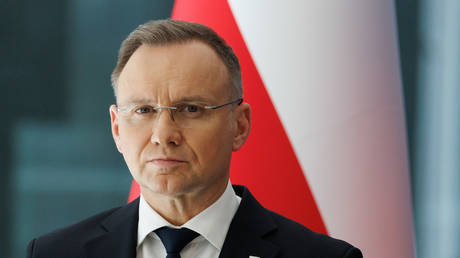 Polish president pours cold water on fears of Russian attack
Polish president pours cold water on fears of Russian attack
According to Borrell, while a military conflict in Europe is not imminent and “not going to start tomorrow,” citizens should understand that the “US umbrella that has protected us during the Cold War and after, may not be open all the time.”
“Maybe, depending on who is ruling Washington, we cannot rely on the Americans’ support and American capacity to protect us,” he said.
Describing the EU as being surrounded by a “ring of fires” and instability, Borrell called on member states to become more self-sufficient with their security and to ramp up their defense spending.
He added that while NATO is as “irreplaceable” as ever, Europeans should start building their own “pillar” within the US-led bloc.
The diplomat acknowledged that Brussels’ stance on the conflicts in Gaza and in Ukraine is not fully shared by many non-Western audiences.
Borrel’s remarks follow suggestions from numerous Western civilian and military officials in recent months that Russia could attack NATO within a few years.
Speaking in late March, Russian President Vladimir Putin dismissed such speculation as “nonsense.” He argued that talk of a potential Russian attack on Poland, the Czech Republic, or the Baltic countries is propaganda coming from governments that seek to scare their citizens “to extract additional expenses from people, to make them bear this burden on their shoulders.”
-
Site: LifeNews
The Dicastery for the Doctrine of the Faith (DDF) released on Monday a new document addressing human dignity, reaffirming the traditional teaching of the Church that not only condemns abortion, sex-change surgery, gender ideology and surrogate maternity as contrary to human dignity, but also adds social justice issues to the list of “equally important” themes for Catholic doctrine.
The declaration Dignitas Infinita on Human Dignity (DI) commemorates the 75th anniversary of the Universal Declaration of Human Rights and reaffirms “the indispensability of the concept of dignity of the human person within Christian anthropology.”
The document clearly restates Catholic doctrine opposing abortion and euthanasia.
It explains that surrogacy “violates the dignity of the woman, whether she is coerced into it or chooses to subject herself to it freely.”
Regarding euthanasia and assisted suicide, it reiterates that “suffering does not cause the sick to lose their dignity, which is intrinsically and inalienably their own.”
DI also addresses gender theory and criticizes how it “intends to deny the greatest possible difference that exists between living beings: sexual difference.”
“This foundational difference is not only the greatest imaginable difference but is also the most beautiful and most powerful of them. In the male-female couple, this difference achieves the most marvelous of reciprocities,” the document continues.
“Only by acknowledging and accepting this difference in reciprocity can each person fully discover themselves, their dignity, and their identity.”
REACH PRO-LIFE PEOPLE WORLDWIDE! Advertise with LifeNews to reach hundreds of thousands of pro-life readers every week. Contact us today.
In its discussion of sex changes, DI states: “it is in the body that each person recognizes himself or herself as generated by others, and it is through their bodies that men and women can establish a loving relationship capable of generating other persons.”
According to the document, this is why Pope Francis has affirmed that “creation is prior to us and must be received as a gift.
“At the same time, we are called to protect our humanity, and this means, in the first place, accepting it and respecting it as it was created,” DI adds.
Except for the opening proposal, which embraces the approach that issues of different moral gravity are still “interconnected,” there are no doctrinal novelties.
Every controversial issue is addressed with quotes from the magisterium.
The Prefect of the DDF, Cardinal Víctor Manuel Fernández, agreed with one of the journalists during the press conference that the text is mostly a “collection of quotes.”
In the introduction, DI justifies its publication by explaining the need to reassert the Catholic teaching regarding human dignity, since “history illustrates how individuals—when exercising their freedom against the law of love revealed by the Gospel—can commit inestimably profound acts of evil against others.”
The introduction is followed by four parts:
1. “A Growing Awareness of the Centrality of Human Dignity” makes the theological case that “dignity is intrinsic to the person” and that “all human beings possess this same intrinsic dignity, regardless of whether or not they can express it in a suitable manner.”
2. “The Church Proclaims, Promotes, and Guarantees Human Dignity” argues how, according to Catholic tradition and theology, “faith plays a decisive role in helping reason perceive human dignity and in accepting, consolidating, and clarifying its essential features.”
3. “Dignity, the Foundation of Human Rights and Duties” explains that although there is significant advancement in human rights issues in the world, “the arduous journey of advancing human dignity remains far from completion.”
4. “Some Grave Violations of Human Dignity” is the longest part of the document and attempts “an updated list” of issues that affect human dignity.
“While not claiming to be exhaustive,” the document warns, “the following paragraphs draw attention to some grave violations of human dignity that are particularly relevant.”
The issues to which a paragraph is dedicated are these, in the order they are presented:
- The Drama of Poverty
- War
- The Travail of Migrants
- Human Trafficking
- Sexual Abuse
- Violence Against Women
- Abortion
- Surrogacy
- Euthanasia and Assisted Suicide
- The Marginalization of People with Disabilities
- Gender Theory
- Sex Change
- Digital Violence
In all these issues, Catholic doctrine is reaffirmed with quotations mostly from Pope Francis’ magisterium.
“Even today, in the face of so many violations of human dignity that seriously threaten the future of the human family, the Church encourages the promotion of the dignity of every human person, regardless of their physical, mental, cultural, social, and religious characteristics,” DI states in its short conclusion.
LifeNews Note: Joshua Mercer writes for CatholicVote, where this column originally appeared.

The post New Vatican Document Condemns Abortion and Surrogacy Because Humans Have Dignity appeared first on LifeNews.com.
-
Site: Zero HedgeStocks Face Rug-Pull From Extreme Momentum MoveTyler Durden Tue, 04/09/2024 - 09:05
Authored by Simon White, Bloomberg macro strategist,
Momentum stocks are very stretched. A reversal exposes the equity market to the risk of a potentially sizable correction, with rising inflation a potential catalyst. Portfolios taking advantage of cheap hedges are better placed to weather any fall in prices.
Momentum is leading the charge in the current rally, with it being the best performing of the most popular types of factor. But the trend is looking increasingly extended.
On a quarterly basis, you have to go back over 30 years before you decisively see more extreme outperformance in the factor.
The two most recent times showing a similar degree of relative upside were March 2022 and June 2008, neither of which were particularly propitious for the stock market.
That’s a risk that it would be folly to ignore, especially as — even if the market escapes unscathed — portfolio hedges remain cheap (although that is already changing as vol begins to rise — discussed here last month).
Momentum’s popularity means when the unwind comes, it has the potential to be severe. Hedge-fund portfolios carry a record tilt to momentum, according to Goldman Sachs.
Source: Goldman Sachs
Furthermore, JPMorgan sees record high crowding in momentum stocks (i.e. stocks that are part of momentum-factor portfolios).
Source: JP Morgan
Momentum’s blessing is also its curse. Momentum begets momentum, driving the market yet higher. But when the trend changes, momentum strategies can quickly go into reverse, selling stocks that are falling. In some cases, that can cause the market to correct, or worse. That risk is especially elevated when everybody’s in the same trade, as is the case today.
The prognosis is not good from a historical standpoint. The quarterly outperformance of MSCI’s momentum factor is at 13 percentage points. The forward return of the MSCI US is negative on a one and three-month basis when the quarterly outperformance is more than 10 percentage points, and it is well under the average on a six-month horizon. History is telling us too much momentum is a bad thing.
But it could be even worse given the current set up. Momentum is a key reason why the stock market has managed to rally despite elevated and rising yields. Of the most common factors (using the Bloomberg market-neutral factor indexes), momentum currently has the highest beta-and-correlation combination to changes in US 10-year real yields.
This is almost exactly inverse to the S&P, which has a very negative correlation and beta to 10-year real yield changes. It is unusual to have this combination. But it is a mix that has allowed stocks to continue rallying despite higher real yields.
Why? In the months when yields have risen, the index was down slightly, but the momentum factor was up strongly. In months when yields were down, the momentum factor fell by more than the index rose. But as yields increased in about twice as many rolling-month periods as they fell since the rally began in October 2022, overall the market has been able to rise — despite real yields rising over 150 bps.
The positive yield-versus-momentum correlation and the negative yield-versus-index correlation started to develop at the beginning of 2022, before inflation had topped, but around the time when the peak was soon anticipated. A re-acceleration in inflation would likely trigger a reversal in this trend, with elevated real yields quickly becoming a problem for stocks.
We will get March data for US CPI on Wednesday. Disinflation has already stalled, while leading indicators see a re-rise in inflation.
Assets are not priced for this eventuality. Among the biggest stocks in many momentum portfolios are tech firms, such as Nvidia, Meta and Broadcom, which have high duration and are therefore in the inflation headlights. With such extreme crowding in the momentum space, a re-increase in CPI has the potential to trigger a selloff that could develop into a nasty correction, or worse.
Top 10 Stocks in iShares MSCI US Momentum Factor ETF
It comes at a time of potential short-term headwinds from liquidity as taxes are paid to the Treasury. The Treasury General Account at the Federal Reserve has its largest average two-week rise in the second half of April — leading to the removal of market liquidity, all other things equal — until the Treasury re-injects the money back into the system.
It’s probably not enough to derail the bull market as recession risk remains low and excess liquidity is supportive, but that doesn’t mean it won’t be uncomfortable.
Equity hedges, though, still remain cheap.
Other hedges include VIX call options (vol of vol remains low), short credit, and bond volatility.
Momentum signals for US stocks, such as Z scores of returns, look to have peaked and are rolling over. That brings forward the time when systematic strategies such as CTAs start to exit high-momentum and crowded stocks.
A trickle of selling could turn into a flood. Momentum begets momentum — until it doesn’t.
-
Site: RT - News
Berlin has deployed the first soldiers from a promised 4,800-strong force to Lithuania
Germany has sent an advance military team to Lithuania as part of plans for a full-strength armor brigade permanently stationed in the Baltic state, which borders Russia. Moscow has described the mission as a threat that requires “special measures” in response.
German Defense Minister Boris Pistorius was among those to see off 21 military service members and civilian employees who departed on Monday from Berlin to Vilnius. The minister praised the Bundeswehr deployment as “a clear signal of solidarity” with Germany’s fellow NATO member.
The Lithuanian Brigade, or Panzerbrigade 45, is set to include some 4,800 soldiers and 200 civilian employees by the time it becomes fully operational in 2027. It will be hosted at the Rudninkai training ground in the southeast of the country as well as near the town of Rukla. Some German troops will be located just 20km from the border with Belarus, a key Russian ally. Lithuania also borders the Russian enclave of Kaliningrad.
Lithuania, which has for years been upgrading the infrastructure needed to house foreign troops, has described the German deployment as historic. The arrival of the advance team four months after the roadmap for the permanent mission was signed heralds “a new page of a deeper Lithuanian-German partnership,” Defense Minister Laurynas Kasciunas declared as he welcomed the troops.
Read more German ‘heavy brigade’ to deploy close to Russia’s border
German ‘heavy brigade’ to deploy close to Russia’s border
Vilnius has touted the German force as a deterrent against Russia, although Moscow perceives it as yet more evidence that NATO is encroaching on its borders.
“This continues an escalation of tension, the creation of hotspots of threats to us at our borders, which will certainly require special measures to ensure our security,” Kremlin spokesman Dmitry Peskov said.
Moscow has accused Washington of ignoring its concerns over NATO enlargement in Europe, which was done in breach of promises made to the Soviet leadership when it agreed to German unification in the early 1990s.
The current hostilities between Moscow and Kiev, which the US-led military bloc claims requires an increased presence in Eastern Europe and the Baltics, was triggered by NATO’s creeping expansion into Ukraine, according to Russian officials.
READ MORE: Finland sees no chance for peace in Ukraine
Since 2017, German troops have been part of the so-called ‘enhanced Forward Presence Battlegroup Lithuania’, a multinational 1,700-strong force stationed in Rukla.
-
Site: LifeNews
Catholic leaders in the pro-life movement weighed in on former President Donald Trump’s Monday announcement that abortion should be a state issue.
“The states will determine by vote, or legislation, or perhaps both, and whatever they decide must be the law of the land – in this case, the law of the state,” stated Trump, the presumptive 2024 Republican Presidential nominee.
“Many states will be different,” he added. “Many states will have a different number of weeks … at the end of the day it is all about the will of the people.”
Also in his announcement, Trump expressed support for in vitro fertilization (IVF) saying, “The Republican Party should always be on the side of the miracle of life … IVF is an important part of that.”
“The federal government cannot abandon women and children exploited by abortion. Leaving abortion policy to the states is not sufficient,” CatholicVote wrote on X (formerly Twitter) Monday morning.
“While federal legislation on abortion policy is challenging at present, we are confident that a Trump administration will be staffed with pro-life personnel committed to pro-life policies, including conscience rights, limits on taxpayer funding of abortion, and protections for pro-life states,” CatholicVote added:
President Trump’s latest statement on abortion reflects the electoral minefield created by Democrat abortion fanaticism. The fact remains that pro-life voters need to win elections to protect mothers and children.
REACH PRO-LIFE PEOPLE WORLDWIDE! Advertise with LifeNews to reach hundreds of thousands of pro-life readers every week. Contact us today.
Further, Democrats are now preparing a billion-dollar election year barrage with radical abortion as its centerpiece. While Trump did not commit to any specific pro-life policies, he notably will not stand in the way of states that have acted to protect innocent children from the violent abortion industry.
“The contrast between Joe Biden and the Democrats and President Trump is unmistakable,” CatholicVote’s statement concluded. “Pro-life voters have only one option in November.”
Students For Life America President Kristan Hawkins indicated that while she supports a pro-life law at the national level, Trump’s decision to punt on endorsing one was a “strategic position.”
“GOP insiders were calling for a 15 or 16 week limit on abortion, which would’ve allowed more than 9 out of 10 abortions to continue, and, by either intent or by accident, would set up a very tough European-like stalemate on abortion,” Hawkins explained on X.
She wrote that Trump’s emphasis on addressing abortion at the state level “keeps the pressure on Democrats and their abortion extremism instead of letting their fundraising machines stir up their radical base over threats about a [federal] late-term abortion ‘ban’ that would only save 4-6% of children.”
“Our ultimate goal in the pro-life movement is federal protection of human life,” Hawkins added. “Your human right not to be killed shouldn’t begin or end at a state line. However, it’s going to take time to get there.”
“Trump made the right call – and this leaves room for better action to be taken down the road,” she stressed.
The post Pro-Life Leader: The Best Option for Christian Voters is Donald Trump appeared first on LifeNews.com.
-
Site: southern orders
Crux has a “live update” of its original article on DI by various theologians. You can read it HERE.It is a good and comprehensive moral document. It is very strong and unambiguous, odd for Pope Francis, in many places especially at it concerns what God has defined a the crown of His creation being humanity, created in His image and likeness, male and female he created them.
While some areas could have been tweaked better for clarity, there isn’t much to complain about. For Pope Francis, we dodged a bullet of grotesque ambiguity. That’s a miracle!
HERE’S MY EXCEPTION:
I think the document speaks about sin only twice. That’s the fly in the ointment for me. Let me explain.
I understand that this document is aimed not only at Catholics but to a worldwide audience of believers and nonbelievers. Thus it is an apologetic for the Church’s teaching on the dignity of life trying to convince the skeptical in worldly terms and appealing to the moral good in people often tainted by politics, polls, and how people feel about this, that or the other. In other words, there are for many Catholics and for most non-believers no moral imperatives set in stone that can’t change with the times and people’s opinions.
While I understand this approach and appreciate it to a certain extent, I think the Magisterium of the Church has to declare moral teachings that affect the world not only in the here and now, but as a preparation for heaven or, failing to follow the narrow road of God’s salvation, affecting people not only here but in the afterlife in terms of either damnation or salvation.
Yes, the Kingdom of God is here but not yet. That’s the irony of salvation. And yes, in this life, we must be workers for Christ in bringing heaven to earth as a sign of the salvation that awaits us.
There is no warning to the world, the flesh and the devil, that failing to promote the dignity of life in all its aspects not only damages the world in which we live bringing death and destruction to those who are defenseless, but will affect the final destination of the choices they make that harm the common good and the most innocent but also the guilty, and that destination is damnation or the fires of hell.
There is no “soteriology” in this document as I understand the study of salvation apart from trying to make life better in the here and now.
And to that end, post-Catholics like our current President Biden, are idealists too, in terms of the political ideologies which become like a fake religion in the moral realm. All that they promote that is opposed to this document, DI, they think too they are improving the world, by allowing a woman to kill her baby up to the end of her pregnancy and even afterward. They think it will create a better world to euthanize those who are compromised in any way to include assisted suicide. They think that a non-binary approach to huaman sexuality and making the choice of being sexually what ever someone feels they are is for the common good.
They are wrong, dead wrong. And for a Catholic president and any Catholic who buys into the political agenda of certain political parties throughout the world who promote these post-Christian evils, eternal damnation awaits.
There needs to be a better call to eternal salvation in Jesus Christ in this document and it is lacking. It reads like just one more political statement in a world of multiple moral, immoral or amoral political ideologies.
-
Site: Ron Paul Institute - Featured Articles
The following remarks were delivered at a conference marking the 25th anniversary of the NATO bombing of Serbia: “The 1999 Red-Green Bombing Terror against Serbia,” held on March 20, 2024, at the Bundestag in Berlin hosted by MdB Dr. Rainer Rothfuß and his Alternative for Germany parliamentary group.
In 2004, I appeared as the second defense witness called by Slobodan Milošević at his so-called “trial” before the so-called “International Criminal Tribunal for the former Yugoslavia” at The Hague My testimony was not as an expert witness but as a witness of fact concerning the formulation and implementation of US and western policy. I addressed one specific charge: that – beginning no later than October 1998 – Mr. Milošević was the initiator of a criminal conspiracy to drive the Albanians out of Kosovo and Metohija on the basis of their ethnicity.
There was one little problem with this accusation: there was absolutely zero direct evidence for it. No written order to this effect was ever produced. No person testified as to having received, transmitted, or even heard of such an instruction. Rather, the claim was based solely on circumstantial inferences of events starting from October 1998.
Thus, the heart of my testimony related to a paper I issued on August 12, 1998, as an analyst at the US Senate Republican Policy Committee, titled “Bosnia II: The Clinton Administration Sets Course for NATO Intervention in Kosovo.” In that paper, working solely from open sources, I detailed how, at that time – fully two months before the Milošević-led supposed “criminal conspiracy” came into effect —
“ … planning for a U.S.-led NATO intervention in Kosovo is now largely in place, …. The only missing element appears to be an event—with suitably vivid media coverage—that would make intervention politically salable, even imperative, in the same way that [the] Administration finally decided on intervention in Bosnia in 1995 after a series of ‘Serb mortar attacks’ took the lives of dozens of civilians—attacks, which, upon closer examination, may in fact have been the work of the Muslim regime in Sarajevo, the main beneficiary of the intervention. . . That the Administration is waiting for a similar ‘trigger’ in Kosovo is increasingly obvious: [As reported in the Washington Post, August 4, 1998], ‘A senior U.S. Defense Department official who briefed reporters on July 15 noted that “we’re not anywhere near making a decision for any kind of armed intervention in Kosovo right now, … [but] I think if some levels of atrocities were reached that would be intolerable, that would probably be a trigger”.’ ”
Now, if I was aware of this as early as August 1998, so were a lot of other people in Washington. I submitted to the “Tribunal” that in light of my paper, all interpretations of events would have to be drastically reevaluated. The issue wasn’t any longer whether Belgrade was planning an expulsion but that Washington was looking for a pretext for aggression.
(My cross-examination by prosecutor Geoffrey Nice (later Sir, based on his work at The Hague), asked me barely a word about my testimony. Rather, he interrogated me about my ethnic origins (Greek, from four Spartan grandparents), my religion (Orthodox Christian), and my opinions about the Islamic challenge to European, Christian civilization (negative).)
As we know, in due course the suitable “trigger” was found, with the so-called “Račak massacre” of January 1999. The key figure in “selling” Račak was William Walker. As described by Mark Ames and Matt Taibbi (now of Rolling Stone) in their article “Meet Mr. Massacre,” published in the now-defunct The Exile of February 10, 2000:
Years from now, when the war in Serbia is over and the dust has settled, historians will point to January 15, 1999 as the day the American Death Star became fully operational.
That was the date on which an American diplomat named William Walker brought his OSCE war crimes verification team to a tiny Kosovar village called Račak to investigate an alleged Serb massacre of ethnic Albanian peasants. After a brief review of the town’s 40-odd bullet-ridden corpses, Walker searched out the nearest television camera and essentially fired the starting gun for the war.
From what I saw, I do not hesitate to describe the crime as a massacre, a crime against humanity,’ he said. ‘Nor do I hesitate to accuse the government security forces of responsibility.’
We all know how Washington responded to Walker’s verdict; it quickly set its military machine in motion, and started sending out menacing invitations to its NATO friends to join the upcoming war party.Focus on that phrase: “the American Death Star became fully operational.” Kosovo became the template that we then took on the road in one form or another in Afghanistan, Iraq, Libya, Syria, Yemen. Ukraine.
But the question still lingers: Why? Why was Washington so insistent that we and our NATO satelli– oops – “allies” needed to launch that war? Why did then-Secretary of State Madeleine Albright reveal in confidence, according to a reliable source, that at Rambouillet “We intentionally set the bar too high for the Serbs to comply. They need some bombing, and that’s what they are going to get”?
Some people will tell you it was about putting a NATO base, Camp Bondsteel, in a strategic location. Or that we wanted to clear the way for an East-West energy pipeline across the Balkans. Or that we coveted the mineral wealth of the Trepča mines. Or to secure the transit route for Afghan opium processed into heroin bound for Europe.
Certainly, all of our various interventions line a lot of a pockets, but in more than three decades of work in and around the Washington apparat, I never heard anyone point to such concrete and, frankly, normal if immoral imperial considerations.
Rather, answers must instead be sought within the larger perspective of American policy since the end of the first Cold War in 1991 and the development of the current one in the course of the 1990s: the American “unipolar moment,” as the bipartisan US policy nomenklatura sought to consolidate and perpetuate its hegemonic control over the entire planet, taking advantage of the vacuum left by the demise of the USSR. Perhaps the fullest expression of this was a 1996 Foreign Affairs article by neoconservative ideologists William Kristol and Robert Kagan (NOTE: Victoria Nuland’s husband), misleadingly titled “Toward a Neo-Reaganite Foreign Policy,” in which they called for the US to establish and maintain indefinitely “benevolent global hegemony” — in other words, perpetual American world domination.
Kristol and Kagan laid out virtually all of the elements that have guided US global policy during the ensuing years. It is no accident that Republican neoconservatives were enthusiastic supporters of Bill Clinton’s Balkan interventions of the 1990s, under the guidance of people like then-Secretary of State Madeleine Albright, who once opined regarding the sanctions-related deaths of a half million Iraqi children that “the price is worth it.” In the US establishment, there is little dissent on either side of the partisan aisle with Albright’s view that a militant United States has a special wisdom: “If we have to use force, it is because we are America; we are the indispensable nation. We stand tall and we see further than other countries into the future …”
The result is a kind of neo-Bolshevik ideology, where, as the vanguard of all progressive humanity, the US leadership class sees itself as the midwife of history. America took the path (as characterized by Russian Foreign Minister Sergey Lavrov) of the “replication of the experience of Bolshevism and Trotskyism”—morphing ourselves into a new Evil Empire in place of the old one. (Anyone familiar with the origins of America’s neoconservatives understands that the Trotskyite reference is not just rhetorical.)
Which brings us back to the “Why?” regarding Kosovo. When the dissolution of Yugoslavia kicked off in June 1991, largely at the initiative of Austria and Germany, official Washington was terrified that with the end of the Soviet bloc Europe might become “whole and free” – but without us. What then could be the future of Lord Hastings Lionel Ismay’s mission for NATO of keeping the Americans in Europe, the Russians out, and the Germans down? Europe, the crown jewel of the Global American Empire (the GAE) was slipping away.
Hence, as former Chairman of the Senate Foreign Relations Committee Richard Lugar (R-Indiana) indicated, NATO needed to go “out of area or out of business.” Starting in spring 1992, Washington moved swiftly to expand the conflict from Slovenia and Croatia (where it had been relatively contained) to Bosnia and Herzegovina. There the US became the vociferous champion of the Muslim faction, illegally shipping in al-Qaeda fighters and Iranian weapons via covert C-130 flights into Tuzla. We then engaged in a little demonstrative bombing of the Bosnian Serbs to set the stage for the Dayton Agreement. The arsonist sets the fire, so then he can be the hero rushing to the rescue: “See, you silly ‘dispensable’ European children? You just can’t get along without us …”
Following Dayton, Kosovo was the other shoe that needed to drop – with appropriate violence – to ensure that Europe was totally, abjectly, humiliatingly subservient to the United States through NATO, with the passive complicity of NATO’s concubine, the European Union. The corollary was that, just as the Serbs had no legitimate voice in determining post-Yugoslav structures, the Russians understood they had no legitimate voice in European security arrangements. These would be decided without them.
Now, of course, with defeat looming in Ukraine and with the broader Middle East on the edge of a regional conflagration, with many in Washington beating the drums for war with Iran or even China, the GAE’s “unipolar” moment is coming to an end, one way or the other, either with a bang or with a whimper. Unfortunately, neither in Washington, nor in Berlin or other European capitals, with the exception of Budapest, are decisions made by people who can be regarded as mentally and morally healthy human beings, much less patriots.
The next few months and years promise to be a period of disorder and acute danger. The question is, can we – Americans and Europeans alike – find a path to governance that can secure a future for our peoples?
-
Site: Zero HedgeIn The Next Several Weeks, We Could See $300 Billion Of Liquidity Leaving The SystemTyler Durden Tue, 04/09/2024 - 08:25
Submitted by Larry McDonald, creator of the Bear Traps Report and author of the newly published book "When Markets Speak" which has been #1 on Amazon over the last week across most non-fiction, finance categories.
What’s Under the Surface?
The heart of “conditioning bias” comes down to one sentence. The longer something works, the more players get drawn into playing the game. We know the junkies are on every street corner these days buying call options when the VIX is up 29% since late December with equities as measured by the S&P 500 – up just a touch more than 9% higher.
Over the last 30 years — most of the time, the CBOE Volatility Index has been supported by investors looking for downside protection in buying puts. But 2024 is much like 1999. For most of that year, the same thing occurred. Today, many players on the field say “greed is good” and they’re all buying upside.
They Love to Buy the 20 Day Moving Average
As the market grinds higher – more and more capital came into the hands of algos and quants buying the 20-day moving average. This is an important area to keep an eye on. There are so many players involved, that a violation of the 20-day moving average will likely come with a meaningful flush lower.
What Could Alter the Equation?
In the next several weeks, we could see about $300 billion of liquidity leaving the system. This is in large part due to the tax deadline on April 15 (see "$265 Billion In Capital Gains Tax Selling: Morgan Stanley Warns Momentum Mauling Is Coming, Thanks To The IRS"). We should expect large tax revenues, in part because taxpayers have significant capital gains from the 2023 equity bull run. Treasury bill issuance will flip negative in Q2 to the tune of about $150 billion as the government runs a budget surplus for a cup of coffee. Add to that the $95 billion in monthly QT (quantitative tightening, Fed balance sheet reduction) and we could see $250 billion of liquidity drain. On top of that, this month about $75 billion of the emergency bank lending facility (BTFP loans) expired and since the facility is now closed, they may not get renewed. This causes another contraction in bank reserves.
Keep in mind, that S&P 500 companies are still in the buyback blackout period, which means that they cannot buy back their stock until they have reported earnings. Stock buybacks are about $100BN per month, so this upward pressure on stocks is currently gone.
Equity Volatility is Cheap vs. Encroaching Risks
The combination of the cocktail ingredients listed above makes the market very vulnerable and at risk of a larger drawdown if any geopolitical risk comes to the surface. Each week, Iran and Israel look toward retaliation, and the probability of escalation is rising. Brent is up nearly 30% since December, putting significant pressure on higher bond yields. Over the same period, the yield on U.S. 10-year Treasuries has moved from 378bps (3.78%) to 440bps (4.40%).
One of the biggest drivers of the stock market since early 2023, and especially since late October, has been liquidity. In an election year of course, Treasury Secretary Yellen and Fed Chair Powell have carefully rebuilt a big chunk of the excess liquidity that underpinned the stock market rally. The two main reasons for the liquidity boost have been to — a) stabilize the banking system after SVB (Silicon Valley Bank) blew up a year ago and — b) to suppress volatility in the election year. A large amount of that liquidity has come from the Reverse Repo Facility (RRP). This is a facility the Fed brought to life in 2020 to mop up some of the excess liquidity from all the Fed’s juicy new programs used to stabilize the financial system during the Covid Financial Panic.
Pick up our latest book “When Markets Speak“ which has been #1 on Amazon over the last week across most non-fiction, finance categories.
Remember, the Fed injected $3.3T of liquidity into the system that year. Fast forward to the end of 2022, and there was almost $2.5T in this RRP facility. Ever since, Treasury Secretary Yellen has been using this money in this honey pot, the RRP to finance her ~$2.5T of bill issuance. The way this works is that when the Treasury ramps up bill issuance, it will push up bill yields. At some point that yield we go above the rate on these reserve balances in the RRP. This is what the Fed pays investors, mostly money market funds, to keep money in the RRP. These investors get lured into the bills market with its higher rates and they take their money out of the RRP and buy bills with it. The money in the RRP is not considered to be part of overall liquidity, so if that money leaves the RRP and enters the bills market, it adds to the liquidity pool. Much of this money has ended up in a special component of the commercial banks’ balance sheet called the reserve balance held at the Fed. In the past, the Fed injected liquidity into the system via QE, which also increased these reserves. But in the last year, the bank reserves expanded primarily from the RRP depletion, and the Fed’s introduction of the Bank Term Funding Program in March of last year. This program allowed banks to borrow from the Fed and use their bonds at par as collateral. This was done to inject liquidity into the banking system to avoid a cash shortage at mainly regional banks following the blow-up of SVB.
Excess Liquidity, Bitcoin, and the S&P
Excess liquidity have surged higher in the last year, which has pushed up risk assets, such as bitcoin and equities.
Together with the introduction of the BTFP in March ’23, the Fed and Treasury pushed up bank reserves from $3T on Oct 22, to $3.6T by March ’24. What do these reserves do? These reserves cannot leave the banking system and therefore cannot enter the “real economy”. It’s a financial form of money only for banks. They can transact in reserves with each other and settle repo and reverse repo transactions. They account for high-quality liquid assets (HQLA) together with bonds and mortgage-backed securities (MBS). Most importantly, banks use the reserves to buy bonds from each other. In this way, they drive liquidity into the market and drive investors into riskier assets. We see that almost every time reserves go up, risk assets benefit.
Bank Reserves Go Up when RRP Goes Down and Vice Versa
As the Treasury pushed money out of the RRP, bank reserves held at the Fed have gone up simultaneously. This has been one of the biggest driver of stock market gains
In the next few weeks, we could see liquidity reverse for two reasons.
- 1) Treasury bill issuance will flip negative in Q2 to the tune of about $150bl. In Q1, 400bl of capital went from the RRP into the bills market, and in Q2 this will reverse. Add to that the 95bl in monthly QT and we could see 250bl of liquidity drain.
- 2) Expiration of the BTFP. In April about 75bl of BTFP loans expire and since the facility is now closed, they may not get renewed. This causes another contraction in bank reserves.
Overall we could see over $300bl of contraction if Yellen/Powell do not step in to offset. We think they will step in but it might take a month or so for them to react.
In the meantime, we are still in the buyback blackout window ($100bl of monthly buybacks do not start anew until after GOOG/AAPL report in late April/Early May) so we could fly into an air pocket.
In the next blog post, we will explain how Yellen and Powell can and will come up with a solution if they see liquidity plunge too far or stock market volatility surges higher.
-
Site: southern orders
-
Site: PaulCraigRoberts.org
Ivermectin Emerges as a Significant Aid in Cancer Treatment
Paul Craig Roberts
Roman Balmakov of EpochTV is the best news presenter in the business. In this 13 minute video Balmakov reports successes from the use of Ivermectin in cancer treatment. https://www.theepochtimes.com/epochtv/ivermectin-as-a-powerful-drug-for-fighting-cancer-a-look-at-the-evidence-facts-matter-5622050?utm_source=Enews&utm_campaign=etv1-2024-04-05&utm_medium=email&utm_content=upvideo&est=AAAAAAAAAAAAAAAAceE5JjMFys3H%2BbdAvWpUcQzPZ0WlGLZbDFlFfmdQNQ%3D%3D
As I reported during the 3 years of orchestrated Covid hysteria, both HCQ and Ivermectin are preventers and cures of Covid. The medical authorities knew this, but they suppressed it,
because if they acknowledged that a cure existed, the Covid “vaccine” could not be released under emergency authorization.As the “vaccine” had not gone through the required testing, it could not be released for use under normal conditions. Therefore, it was a known risk, and the emergency use authorization protected the pharmaceutical companies from liability.
As the “medical authorities” –FDA, CDC, NIH, WHO–are all shills for the profits of Big Pharma and exist in a revolving door relationship with Big Pharma–Fauci himself shared patent ownership with Big Pharma–an untested vaccine was falsely and illegally released under false pretenses. Big Pharma made billions of dollars, and millions of “vaccinated” victims died or had health injuries. This is an established fact, not a “conspiracy theory” as Big Pharma’s “fact checkers” proclaim. It is an established scientific fact totally ignored by the whore media, medical boards, and the Big Pharma operatives that constitute the “medical regulatory authorities.”
As a consequence of legislation lobbied to passage by Big Pharma and insurance companies, fewer and fewer doctors are in private practice. Instead they are employees, which means they are accountable to their employer, some HMO, and not to their patients. Medical insurance has not adjusted to this fact.
I have a friend who is a doctor employed by a HMO. Observing the failure of ventilators and the non-treatment process for Covid, he cured patients with Ivermectin. Three times he was called in by his employer and ordered to stop treatment with Ivermectin. He ignored the orders on the grounds that they were an illegitimate interference in the doctor-patient relationship and an interference in his obligation to his patients and the Hippocratic Oath. Understanding that a fourth reprimand was a firing, leaving his patients unprotected, he diagnosed Covid infected patients with lupus and other health problems traditionally treated with Ivermectin or HCQ.
In other words, in the “free” United States of America, now seen worldwide as “a shithole country,” the only way a conscientious medical doctor should serve the health of his patients was through subterfuge.
Recently, as I reported, a federal court ordered the Big Pharma marketing agent, the FDA, to remove its online warnings against the use of Ivermectin, a long approved drug for general use based solely on the doctor’s opinion. All of the totally corrupt federal agencies–FDA, NIH, CDC, along with Bill Gates’ WHO–declared Ivermectin, long a preventer in Africa of River Blindness, to be a “horse medicine.”
No one in Africa taking Ivermectin as “the Sunday medicine” to prevent river blindness got Covid.
No one in Africa taking HCQ as “the Sunday medicine” to prevent malaria got Covid.
Four states in India successfully used Ivermectin to prevent Covid, did not use the “vaccine” and experienced little, if any, Covid. The same in parts of Brazil.
Today it is the Covid-Vaccinated countries where athletes in their prime are dropping dead on the playing field, where entertainers are dropping dead during performances, where airlines are running out of pilots due to the airline vaccine mandates, where babies and kids are dying from heart attacks, where never before seen turbo cancers are appearing among children and adults, where male and female fertility are declining, where miscarriages are rising.
The question before us is: Will the scientific information reported by Balmakov advance the use of Ivermectin in the cure and prevention of cancer, or will Ivermectin, a very inexpensive medicine, be seen as a threat to the existing institutionalized profitable treatment of cancer, which basically destroys a person’s immunize system so cancer can win.
Americans being naive souls trusting authority are perfect victims for the likely renewed demonization of Ivermectin.
Indeed, we have a forerunner from federal “medical authorities” who have set their sights on banning NAC, a long-used supplement that greatly improves human health.
The last thing Big Pharma wants is a healthy population. Big Pharma needs a sick population for its profitability. Indeed, Big Pharma creates vaccines and “medicines” that make us sicker so we need more medication.
Insouciant Americans don’t understand that Big Pharma controls medical research and increasingly the curriculums of medical schools. Not long ago when the editors of the two most prestigious medical research publications resigned, the New England Journal of Medicine and The Lancet, both said that they had no confidence in the articles that their journals published, because 70% of the articles were written with Big Pharma grants.
In the world today, American youth are the most medicated, vaccinated kids in the world, and hardly any of them are healthy.
The question before us is: How did a people intended by their founders to be the most free in human history end up subservient to official narratives that destroy their freedom, their health, their independence?
Why is the American population content with its impotence and loyal to a government that is unaccountable to the people?
The only answer is that the insouciant American population has zero awareness of their situation. When people don’t understand that they are threatened, how can they resist a threat of which they are unaware?
It is not Putin, XI, Iran, who are overthrowing America. America has been overthrown by the insouciance of the population.
-
Site: Zero HedgeFutures Flat In Cautious Trade Ahead Of CPI As Gold Roars To New Record HighTyler Durden Tue, 04/09/2024 - 08:10
US equity futures are trading in a narrow range, swinging between gains and losses as bonds climbed, clawing back some of Monday’s slump which sent yields to the highest since last November in the buildup to US CPI print tomorrow that is crucial to the Fed's decision when it will start to cut interest rates; Government debt in the UK and Germany followed suit, with yields falling across the curve after a 20-year UK bond sale drew record demand from investors. As of 8:00am, S&P futures were up 0.1% but traded tightly around the unchanged line as they extended Monday’s flat close on Wall Street, when trading was the thinnest since Christmas. Nasdaq futures gained 0.2% while Europe's Estoxx 50 was down about 0.5%, with technology and industrials leading to the downside. Commodity markets are higher lead by Energy and Metals, with Gold hitting a new record high, rising as much as $25 to $2,365 before paring gains. The macro picture is light today but keep an eye on the 3Y auction, which may give some cues to investor positioning ahead of the CPI.
In premarket trading, Mag7 names are mixed with Semis up. Blackberry rose 6.9% after the Canadian software company announced a robotics collaboration with AMD. Here are some other notable premarket movers:
- ChargePoint shares fell 4.3% as Goldman Sachs downgraded the provider of electric vehicle charging solutions to sell from neutral, on expectations of a slower EV market in the US. Goldman also lowered its rating on sector peer Sensata to neutral from sell.
- Maxeon Solar shares dropped 16% after the solar-panel maker’s first-quarter revenue forecast missed estimates.
Caution dominates sentiment before Wednesday’s inflation report, which is forecast to show some further easing of price pressures but may surprise to the upside after the recent surge in oil prices. Traders are also preparing for the ECB's rates announcement on Thursday, which could support bets on earlier easing by the ECB than the Fed, and for the start of the first-quarter earnings season. While markets now favor just two US rate cuts this year, former Fed St. Louis President James Bullard said three reductions remain “the base case."
For Mohit Kumar, strategist and chief economist for Europe at Jefferies, the more important discussion should be over how the Fed would respond to any signs that resilience in the American economy is faltering. "The right question is whether the Fed is willing to cut rates if there is any sign of weakness,” Kumar wrote in a note to clients. “And on that we are reasonably confident that if the economy weakens, we will see easing from the Fed which would support risk sentiment.”
While economists surveyed by Bloomberg expect the consumer price index will show some cooling in inflation, the core gauge, which excludes food and energy costs, is forecast to be up 3.7% from a year earlier — above the Fed’s 2% target. Concerns, however, are for hotter prints in the future, which reflect the ongoing surge in gold, which rose as much as $25 to $2,365 this morning, a new record high, and up more 17% since mid-February. Copper traded near a 15-month high as supply tightens and global manufacturing picks up.
Marija Veitmane, head of equity markets research at State Street Global, said her firm’s measure of online inflation pointed to a potentially above-consensus read. “We have seen prices in every sector we track to grow at higher than average pace in March,” she said. As for corporate results, “we continue to worry about narrowness of earnings, where majority of growth comes from the tech/large-cap stocks, which majority of companies are showing signs of stress,” Veitmane said. “Falling margins are particular concerns as they tend to precede layoffs.”
European stocks fall with consumer products, construction and real estate underperforming. FTSE 100 outperforms peers, adding 0.2%, DAX lags, dropping 0.6%. In individual stock moves Tuesday, BP Plc rose to a five-month high after an update that analysts said showed a strong performance in oil and gas trading. Renault SA advanced after an upgrade from analysts at Barclays Plc. Mining stocks were a bright spot in Europe as iron ore headed for its biggest two-day rally in more than two years.
Earlier in the session, Asian stocks climbed for a second day, as TSMC helped drive gains in tech shares on investor excitement over its US production plans. The MSCI Asia Pacific Index climbed 0.7%, with TSMC the biggest boost after the US announced an agreement for $11.6 billion in grants and loans to help the chipmaker build factories. Taiwan led gains across the region, with its benchmark index gaining as much as 1.9% to a record high. Stocks also advanced in Hong Kong, Japan and Australia.
- Hang Seng and Shanghai Comp. were varied with the Hong Kong benchmark lifted although the psychologically key 17,000 level continued to elude. Conversely, the mainland lagged after another tepid PBoC liquidity operation, while Premier Li recently noted uncertainty and complexity in the external environment are rising.
- Nikkei 225 continued to benefit from recent currency weakness with USD/JPY lying in wait for a retest of 152.00.
- ASX 200 was led by miners but with gains capped after weak consumer sentiment and a mixed business survey.
In FX, the Bloomberg dollar spot index is flat, while NOK and SEK outperform, and JPY and DKK lag G-10 FX. The yen hovered near a 34-year low and around the closely watched 152 level that many say will trigger Japanese authorities to act.
In rates, treasuries rise, paring some of Monday’s losses that saw 10-year yields climb to the highest since November. Bunds, gilts follow suit as yields across the curve drop; treasuries are richer across the curve by at least 2bp, tracking bigger gains in core European rates. Treasury 10-year yields around 4.39% are down by more than 3bp on the day, but trail bunds and gilts in the sector by ~1.5bp as curve spreads remain within about 1bp of Monday’s closing levels. Gilt and bund futures remain near best levels of the day after UK 20-year bond sale drew record demand from investors. Asia session flows included two 2s10s block flatteners for a combined $650k/DV01 in cash risk. US session highlights include $58 billion 3-year note auction, first of three coupon sales this week. Coupon auction cycle begins at 1pm New York time with $58b 3-year note; $39b 10-year note and $22b 30-year bond reopenings follow Wednesday and Thursday. WI 3-year yield at roughly 4.565% is ~31bp cheaper than last month’s, which stopped 1.3bp through on strong demand.
In commodities, oil traded near a five-month high as investors weighed simmering tensions in the Middle East and persistent supply concerns. Israel said progress has been made in negotiations for a cease-fire in Gaza, signaling a potential easing of hostilities, but Hamas denied the claim. WTI traded within Monday’s range, adding 0.5% to trade around $86; meanwhile base metals are mixed; LME aluminum falls 0.5% while LME tin gains 2%. Spot gold held a record high, rising roughly $20 to trade near $2,359/oz, and up more 17% since mid-February. Copper traded near a 15-month high as supply tightens and global manufacturing picks up.
Looking at today's calendar, there is no US economic data or Fed speakers scheduled for the session
Market Snapshot
- S&P 500 futures little changed at 5,251.25
- STOXX Europe 600 down 0.2% to 507.93
- MXAP up 0.7% to 177.20
- MXAPJ up 0.6% to 541.29
- Nikkei up 1.1% to 39,773.13
- Topix up 1.0% to 2,754.69
- Hang Seng Index up 0.6% to 16,828.07
- Shanghai Composite little changed at 3,048.54
- Sensex little changed at 74,726.49
- Australia S&P/ASX 200 up 0.5% to 7,824.24
- Kospi down 0.5% to 2,705.16
- German 10Y yield little changed at 2.41%
- Euro little changed at $1.0854
- Brent Futures up 0.5% to $90.84/bbl
- Gold spot up 0.8% to $2,357.69
- US Dollar Index little changed at 104.17
Top Overnight News
- The Bank of Japan will maintain accommodative monetary conditions for now, Gov. Kazuo Ueda reiterated Tuesday, while not ruling out the possibility of further policy changes. “We will consider reducing a degree of monetary easing” if underlying inflation rises further, Ueda said in a parliamentary committee meeting. WSJ
- Joe Biden and Japan’s Fumio Kishida plan to form a council on defense industries and allow workers in Japan to perform more maintenance work on US Navy ships, according to a senior administration official. Defense will top the agenda at their meeting tomorrow. BBG
- Berkshire Hathaway plans to sell yen bonds, fueling speculation that Warren Buffett is weighing more investments in Japan. It mandated banks for a potential benchmark SEC-registered bond offering, a person familiar said. BBG
- UBS is in talks to attain full ownership of its China platform by swapping its holding in Credit Suisse’s onshore securities venture with a Beijing government investment fund, people familiar said. BBG
- European banks saw a “further substantial decline” in demand for business loans in Q1 according to a new ECB survey (“higher interest rates, as well as lower fixed investment for firms and lower consumer confidence for households, exerted dampening pressure on loan demand”). ECB
- Blackstone is close to a deal with L’Occitane owner Reinold Geiger to take the Hong-Kong listed company private, people familiar said. Blackstone may provide debt financing for the buyout. BBG
- AI models such as OpenAI’s ChatGPT “are just insatiable in terms of their thirst” for electricity, Arm's CEO Reene Haas said. “The more information they gather, the smarter they are, but the more information they gather to get smarter, the more power it takes.” Without greater efficiency, “by the end of the decade, AI data centers could consume as much as 20% to 25% of U.S. power requirements. Today that’s probably 4% or less,” he said. “That’s hardly very sustainable, to be honest with you.” WSJ
- Former Federal Reserve Bank of St. Louis President James Bullard said he’s expecting three interest-rate cuts this year as inflation moves toward the central bank’s target while the economy remains resilient. “At this point, you should probably take the committee and chair at face value — their best guess right now is still three cuts this year,” Bullard said Tuesday in a Bloomberg TV interview with Haslinda Amin. “That’s the base case.” BBG
- The largest US banks are set to earn higher profits from their lending businesses than expected this year as it becomes more likely that the Federal Reserve will make only modest cuts to benchmark interest rates. FT
A more detailed look at global markets courtesy of Newsquawk
APAC stocks traded mostly higher but with price action relatively rangebound with global markets lacking any major catalysts ahead of upcoming risk events. ASX 200 was led by miners but with gains capped after weak consumer sentiment and a mixed business survey. Nikkei 225 continued to benefit from recent currency weakness with USD/JPY lying in wait for a retest of 152.00. Hang Seng and Shanghai Comp. were varied with the Hong Kong benchmark lifted although the psychologically key 17,000 level continued to elude. Conversely, the mainland lagged after another tepid PBoC liquidity operation, while Premier Li recently noted uncertainty and complexity in the external environment are rising.
Top Asian News
- HKMA said Hong Kong is considering deepening some of the Connect schemes between Hong Kong and Mainland China.
- BoJ Governor Ueda said Japan's economy is showing some weakness but is recovering moderately and the chance of solid wage growth this year is heightening, while he added the BoJ expects accommodative monetary conditions to continue for the time being and it is important to maintain accommodative monetary conditions as trend inflation is yet to hit 2%. Ueda said if the economy and price developments proceed as projected now, they need to think about reducing the degree of monetary support but added whether this will happen will depend on upcoming data and there is no pre-set idea now on how and when they will adjust interest rate levels. Ueda added that even after March policy shift, expect interest rates to stay low and real interest rates to remain at deeply negative territory. Ueda reiterated that if FX moves have impact on economy and prices in a way that is hard to ignore, we will of course respond with monetary policy.
European bourses in the red, Stoxx 600 -0.2%, action is subdued across the board but with some mild divergence in catalysts thin trade. DAX 40 -0.6% the relatively underperformer pressured by heavyweights SAP & Daimler Trucks and despite support in Infineon from TSMC; defence names, including Germany's Rheinmetall, pressured after commentary from GS on defence valuations and earlier geopolitical reports around necessary export licenses. Sectors more broadly do not have any overarching bias/theme, with relative outperformance in Basic Resources and Energy names echoing underlying benchmarks and helping the FTSE 100 +0.1% tread water. Stateside, futures near the unchanged mark (ES +0.1%, NQ +0.1%) with catalysts light thus far and the docket ahead sparse before Wednesday's CPI & Minutes; Tesla -0.3% in focus after a fatal crash lawsuit settled and given the latest CPCA numbers.
Top European News
- Barclays said UK March consumer spending rose 1.9% vs prev. 1.9% increase in February and was the joint-smallest increase since September 2022, according to Reuters.
- EU Competition Chief Vestager is set to pitch a tougher, joint approach to tackling challenges posed by China as part of a speech in the US, via Politico. To say that the EU has accepted a mistake was made a decade ago by the failure to impose restrictions on China's heavily state-subsidises solar panels. Decision from the EU investigation into Chinese subsidies is said to be picking up pace, decisions expected as soon as the summer; Vestager to say if the investigation finds China EV exports have been subsidised than the EU will impose restrictions.
- ECB Bank Lending Survey - Credit standards were broadly unchanged in the first quarter of 2024. Loan demand from firms declined substantially, contrary to bank expectations of a recovery; Corporate credit standards tightened in Q1 but eased for household mortgages; Banks are expecting a moderate net decrease in demand for loans to firms and a net increase in demand for loans to households in the second quarter of 2024 - click here for more.
- Russian Kremlin says there is no specific time frame for a visit by President Putin to China, but the visit of Foreign Minister Lavrov can be considered as preparation for high-level contacts of which there is a need for.
FX
- DXY steady for much of the morning and holding above 104.00; modest pressure came as BoJ sources via Bloomberg pulled USD/JPY away from the 151.93 base and by extension the YTD peak at 151.97 above with USD/JPY down to and holding around a 151.74 base.
- EUR slightly softer initially but has derived some modest support alongside GBP in the wake of the JPY-induced USD-pressure. Though, to be clear, action is contained overall with the magnitude of upside marginal.
- Cable saw a slight acceleration in gains after it surpassed the 50- & 100-DMAs of 1.2663 and 1.2668, to a 1.2685 peak.
- Antipodeans steady but have also benefited from the relative USD pressure in the second half of the European morning with participants looking ahead to the RBNZ which is expected to leave rates unchanged; AUD and NZD near highs of 0.6625 and 0.6055.
- BoJ is said to consider raising its inflation forecast following the "surprisingly strong" results from annual wage negotiations, according to Bloomberg sources; Core CPI is seen revised up from the current forecast of 2.4%. BoJ is likely to forecast price growth of around 2%. Officials also highlight that they need be aware of possible downside risks to inflation when making projections for fiscal 2026.
- PBoC set USD/CNY mid-point at 7.0956 vs exp. 7.2248 (prev. 7.0947).
Fixed Income
- Comparably contained start for USTs with the docket sparse, upside potentially via haven flows as geopols remains in focus. Overnight JGB auction was robust though a touch softer than the prior.
- USTs currently post gains of circa. 5 ticks with yields slightly lower but without a clear flattening/steepening bias thus far.
- EGBs & Gilts outperform, no real reaction to supply which was well received despite the lack of fresh concession into the auction while the latest ECB BLS spurred some modest upside in Bunds which are currently around the 132.29 peak; overall, while bid EGBs remain much closer to last week's 131.87 base than the 133.43 peak.
- Gilts outperform, again no reaction to supply with the DMO back in the market on Wednesday. Possible upside from the latest Barclays data though the BRC numbers showed strong March figures, but these often slump ahead in the post-Easter period. Upside brings 99.00 back into play before Friday's 99.15 peak and Thursday's at 99.37 thereafter.
Commodities
- Crude benchmarks incrementally firmer but with action largely sideways in the European morning; WTI May resides in an USD 86.38-86.94/bbl range, while Brent June is within USD 90.38-90.90/bbl parameters.
- Complex remains focused on geopols after Israel pencilled in a date for the Rafah operation while BP expects Q1 upstream production higher Q/Q; EIA STEO due later.
- European and US gas benchmarks diverge with TTF lower while Henry Hub lifts but price action overall is uneventful and absent specific catalysts.
- UK, Germany, Belgium, Netherlands, Denmark and Norway signed a declaration to protect infrastructure in the North Sea.
- Azerbaijan oil production 481k BPD in March (prev. 476k BPD in February), according to the Energy Ministry.
- Morgan Stanley raises its Q3 Brent oil price forecast to USD 94/bbl to reflect geopolitical risks.
- Precious metals bid despite the relatively stable/modestly firmer USD for much of the morning with support coming from the lower yield environment and with haven flows potentially factoring; spot gold at a fresh USD 2365/oz ATH; base peers see a pullback in LME Copper after Monday's marked strength while Dalian iron ore soared in APAC trade.
Geopolitics: Middle East
- Hamas said Israeli position during last round of negotiations in Cairo remains stubborn and did not meet any demands of Palestinians, while it is still studying Israel's proposal and will inform mediators of its response, according to a statement.
- US Pentagon said Defense Secretary Austin expressed commitment to support an unconditional return of hostages and hopes for a cessation of hostilities through negotiations. Austin also expressed hope that the ongoing negotiations between Israel and Hamas will lead to a truce and he affirmed unwavering US support for defending Israel in light of threats from Iran and its network of proxies, according to Al Jazeera and Al Arabiya.
- US intelligence assesses that Iran has urged several of its proxy militia groups to simultaneously launch a large-scale attack against Israel, using drones and missiles, while they could attack as soon as this week, according to sources cited by CNN. Furthermore, sources familiar with US intelligence said an Iranian attack would likely be carried out by proxy forces in the region, rather than by Iran directly, and one of the sources noted the threat is very clear and credible with the pieces in place to conduct the attack and Iran are just waiting for the right time.
- Iraqi armed faction said they bombed a vital target in Ashkelon in southern Israel and another target in the past 72 hours, according to Al Arabiya.
- US military said it destroyed air defence and drone systems of Houthi forces in an area of the Red Sea, while there were no injuries or damage to US, coalition or commercial ships.
- "Israeli military says it has carried out raids on Syrian army military infrastructure in southern Syria", according to Al Arabiya.
Geopolitics: Other
- EU Foreign Minister Borrell in a speech within Brussels says that "war is certainly looming all around us" and that a "high-intensity, conventional war in Europe is no longer a fantasy", via FT.
- Australia's PM Albanese said Japan is a natural candidate to cooperate on stage two of the AUKUS security pact but added there are no plans to expand AUKUS membership beyond Britain, Australia and the US. There were prior reports that China was 'gravely concerned' as Australia, US, UK confirmed that Japan was being considered for AUKUS.
- Chinese military newspaper said Japan is showing 'obvious offensive characteristics' with its new Okinawa missile unit, according to SCMP.
- The extraordinary session of the IAEA Board of Governors on the escalation of the situation at the Zaporizhzhia nuclear power plant may be convened Thursday, according to Russia's Permanent Representative to International Organizations.
US Event Calendar
- 06:00: March Small Business Optimism 88.5, est. 89.9, prior 89.4
DB's Henry Allen concludes the overnight wrap
Markets got the week off to a subdued start yesterday, with little in the way of fresh developments to drive any new moves. That should change later in the week, as we’ll get the US CPI report, the ECB’s policy decision, and the start of the Q1 earnings season. But for now at least, the main theme has been the continuation of last week’s trends, including more and more doubts about rate cuts this year, and growing fears about inflation. Indeed, the US 5yr inflation swap (+1.0bps) hit 2.57% by yesterday’s close, marking its highest level since October.
Those questions about rate cuts have been clear from market pricing. For instance, the probability of a cut by the Fed’s June meeting was down to just 52% by the close yesterday, where it remains this morning. That’s the lowest since October, back when the 10yr Treasury yield was trading near 5% and there was growing belief in the “higher for longer” narrative when it came to rates. In addition, the total number of cuts priced for 2024 also fell, with just 61.5bps of cuts priced by the Fed’s December meeting, down -3.3bps on the previous day. And it’s clear that trend is happening globally as well, with overnight index swaps taking the chance of an ECB cut by June down from 97% to 91%, and this morning that’s fallen further to 88%. Moreover, the ECB cuts priced by December came down -4.8bps to 84bps, with a further decline overnight to just 80.5bps, which is the fewest so far this year.
With investors pricing in in fewer rate cuts, that’s helped to drive a bond selloff on both sides of the Atlantic. I n the US, it saw the 2yr Treasury yield rise +3.9bps to 4.79%, while the 10yr yield was up +1.8bps to 4.42%, the highest closing levels of 2024 so far for both. At one point intraday, the 10yr yield even moved as high as 4.46%, before coming back down again into the close. Both the 10yr real yield and 10yr breakeven reached year-to-date highs. And over in Europe, there was a similar bond selloff, with yields on 10yr bunds (+3.7bps), OATs (+1.7bps) and BTPs (+1.1bps) all moving higher.
Looking forward, the focus is now on tomorrow’s US CPI report for March, but yesterday’s Fedspeak offered little guidance on the timing of any rate cuts. Chicago Fed President Goolsbee, who’s a more dovish member, noted that if rates stayed high, then “the unemployment rate is going to start going up”. Separately, Minneapolis Fed President Kashkari said that the labour was still tight, although his base case was that inflation would continue to fall.
Earlier in the day, we also had the New York Fed’s latest Survey of Consumer Expectations, but it showed a mixed picture on inflation expectations. The good news was that 5yr expectations fell by three-tenths to +2.6%, but 1yr expectations were constant at +3.0%, and the 3yr measure ticked up again to a four-month high of +2.9%. So no obvious headline on the inflation side. But there were some more negative trends on the labour market, which showed consumers were becoming distinctly less confident. For example, the mean probability of losing one’s job rose to 15.7%, which is the highest it’s been in three-and-a-half years. And the mean probability of finding another job in the next three months if their current job was lost fell to 51.2%, the lowest in almost three years.
When it came to equities, there were signs that the volatility at the end of last week was beginning to subside, with the S&P 500 (-0.04%) seeing little change and the VIX coming down by -0.8pts. Small-cap stocks were an outperformer, with the Russell 2000 up +0.50%. Energy stocks underperformed within the S&P 500 (-0.63%), as oil prices saw a moderate retreat from five-month highs at the end of last week (Brent crude -0.87% to $90.38/bbl). The Magnificent 7 saw a slight outperformance (+0.27%) thanks to a +4.90% gain for Tesla following news late last week that it plans to unveil a robotaxi in August.
Over in Europe, the STOXX 600 (+0.47%) posted its strongest start to a week since February, whilst there were solid gains for the DAX (+0.79%) and the CAC 40 (+0.72%) as well. That strength was evident among other risk assets too, and yesterday saw US HY spreads (-5bps) and EUR HY spreads (-4bps) both tighten. Meanwhile, with the Q1 earnings season coming up, our colleagues in Credit Strategy have sketched their expectations for EUR IG. Although spreads have already tightened a lot since the autumn, they believe earnings should still prove supportive for spreads. See their full report here.
Overnight in Asia, the subdued tone has continued, and there’s been a mixed performance for equities across the region. That includes gains for the Nikkei (+0.86%) and the Hang Seng (+0.55%), alongside modest declines for the KOSPI (-0.12%), the Shanghai Comp (-0.15%) and the CSI 300 (-0.25%). In the meantime, there’ve been fresh losses for Japanese sovereign bonds, and the 2yr yield (+1.2bps) is up to 0.23% this morning, marking its highest level since 2011. That comes amidst comments from BoJ Governor Ueda overnight, who said that he expects Japan’s price trend to increase toward the end of the BoJ’s projection period. Looking forward, US equity futures remain broadly flat, with those on the S&P 500 up just +0.06%. And for US Treasuries there’s been a slight recovery this morning, with the 10yr yield down -1.0bps to 4.41%.
Finally, it’s a quiet day ahead on the calendar, but we will get the ECB’s Bank Lending Survey, and in the US there’s the NFIB’s small business optimism index for March.
-
Site: PaulCraigRoberts.org
Nuclear Armageddon Is Not the Only Extermination Threat We Face
The famous Belgian medical scientist, Geert Vanden Bossche, who warned us against mass vaccination in the teeth of a pandemic, says a second Sword of Damocles hangs over our heads–an outbreak of a new Covid virus strain from mutation within the bodies of the Covid vaccinated. James Howard Kunstler explains:
https://kunstler.com/clusterfuck-nation/this-is-not-an-april-fools-gag/
-
Site: PaulCraigRoberts.org
The Biden Regime Is Committed to Replacing Americans and Is Using Our Money to Replace Us
Destinations Identified for Illegal Alien FlightsAccording to U.S. Customs and Border Protection data analyzed by the Center for Immigration Studies, Florida has been reported as the top landing zone for illegal aliens flown secretly into the country as part of a Biden administration program. Amelia McKenzie reports that as of February, 326,000 of these individuals were flown to Miami.
The Department of Homeland Security has refused to acknowledge these flights, but Members of Congress have spoken out against it.
This secretive program was designed by the Biden administration in an effort to reduce the southern border crossing numbers by flying illegal aliens into the U.S. Once they arrive, the aliens are released on “parole” and can receive two-year renewable work authorizations.
Houston is the second-highest destination for these flights (21,964 individuals), followed by Los Angeles (8,382). The aliens are coming from Venezuela, Cuba, Haiti, Nicaragua, Colombia,
Guatyemale, El Salvador, Honduras, and Ecuador.
Texas Wants Courts to Stop Biden Administration Program for Illegal Aliens
Attorney General Ken Paxton, America First Legal, and a coalition of attorney generals from other states are asking federal courts to reconsider Texas’ lawsuit against the Biden administration regarding the transportation of illegal aliens via air travel into U.S. cities. Will Biagini has the story.
In February, the U.S. District Court for the Southern District of Texas initially dismissed the lawsuit because it believed the program did not sufficiently harm the states.
With new evidence about the size of the program (see article above), the plaintiffs hope the court will reconsider its position.
The states are pointing to the massive number of illegal aliens given parole by the Biden administration and the resulting “significant financial costs” they represent.”
https://blast.texasscorecard.com/t/d-e-eyhjhlt-dryudktlut-ty/
-
Site: PaulCraigRoberts.org
If you can’t make your mortgage or rental payment, your car payment, your credit card payment, your student loan payment, or your child support payment, you can thank Joe Biden and the Democrats’ open border policy.
Lew Rockwell explains: https://www.lewrockwell.com/2024/04/lew-rockwell/invasion-alert/
-
Site: Novus Motus LiturgicusSome NLM readers will already be aware of the Sarum Use Vespers and Benediction that took place on March 1 at the Princeton University Chapel. Here, I present an account of a talk I gave before the event about the art used in the ceremony, which was commissioned especially for the occasion, explaining the choice of content and style, and how it harmonises with the activity of worship. David Claytonhttp://www.blogger.com/profile/07041908477492455609noreply@blogger.com0
-
Site: Zero HedgeUS Small-Business Optimism Slides To 11-Year Low As Bidenomics FailsTyler Durden Tue, 04/09/2024 - 07:45
The failure of Bidenomics has crushed confidence among US small businesses to the lowest level in more than a decade, as the future path of inflation remains a significant concern. Readers must remember small businesses are vital to the economy, contributing 44% of the country's economic activity and creating two-thirds of net new jobs.
The National Federation of Independent Business (NFIB) reported Tuesday that its small-business optimism index declined .9 points to 88.5, the lowest level since the second half of 2012 - or about when the US economy climbed out of the worst financial crisis ever.
Twenty-five percent of business owners identified inflation as the largest issue plaguing day-to-day operations, highlighting the impact of increased costs for inputs and labor. This represents a 2-point increase from February. Additionally, the proportion of businesses that have increased their average selling prices went up by 7 points compared to the previous month.
"Owners continue to manage numerous economic headwinds," Bill Dunkelberg, the group's chief economist, wrote in a statement, as quoted by Bloomberg.
Dunkelberg said, "Inflation has once again been reported as the top business problem on Main Street and the labor market has only eased slightly."
The worsening sentiment among small business owners directly correlates to the rise in consumer prices in the first two months of the year:
- CPI Prints Hotter Than Expected In January As SuperCore Soared
- Inflation Hot: Consumer Prices Hit New Record High, Up 19% Since 'Bidenomics' Began
Rising gasoline prices at the pump, inching closer to the politically sensitive level of $4 a gallon, have likely also contributed to the souring mood.
Last week, the NFIB reported that small businesses' hiring plans in March were the shockingly weakest since May 2020. This report is a major concern, considering small firms are the economic engine of the economy.
The gloom among small business owners is an ominous sign that the US economy is on shaky ground while the federal government recklessly spends to avert a recession before the November elections.
-
Site: southern orders
In my neck of the woods, cloud eclipses of the sun are frequent and bring almost total darkness to our surroundings. Does anyone make a big deal out of these? But if the moon hides the sun, you’s think it’s the end of the world! I just don’t get it.
-
Site: RT - News
Kiev’s duty-free access to bloc’s market will be extended but caps will be placed on items such as honey, eggs, sugar and poultry
EU lawmakers have reached an agreement to extend Kiev’s duty-free access to member states’ market but have decided to also introduce caps on a number of Ukrainian farm imports, the European Council announced on Monday.
The preliminary decision has been approved by EU ambassadors. The agreement will enter into force after it is approved by a European Parliament committee, which is set to meet on Tuesday.
According to the latest arrangement, the exemptions on tariffs initially granted to Kiev in 2022 after the launch of Russia’s military operation in Ukraine will be extended for another year, until June 2025.
However, Brussels has also decided to “reinforce the protection of sensitive agricultural products” and has introduced “automatic safeguards” for oats, corn/maize, and groats, as well as produce like honey, eggs, poultry and sugar, to prevent cheap imports from flooding the EU market.
Specifically, tariffs would be applied to the listed produce if imports of it exceed average levels of past years. The European Commission has also proposed extending this reference period to the second half of 2021, the year before the conflict broke out.
Read more WATCH tractor spray manure at police in Brussels (VIDEO)
WATCH tractor spray manure at police in Brussels (VIDEO)
Previously, it was estimated that these new safeguards could potentially reduce Kiev’s earnings by some €240 million ($260 million) per year.
The decision to limit Ukrainian imports comes as farmers across Europe have been protesting for several months against the EU’s policies, which, agricultural workers say, are threatening their livelihoods.
After the launch of Russia’s military operation in Ukraine, the European Commission lifted all duties and quotas on Ukrainian goods for a period of one year to allow its agricultural products to be shipped to global markets. However, these imports ended up flooding Eastern European countries, destabilizing markets
European farmers have complained that they simply cannot compete with cheap Ukrainian imports that are not subject to the same tariffs and regulations as EU-produced goods.
-
Site: Zero HedgeTraders' Doubts Fed Can Hit Inflation Goal Underscore CPI RisksTyler Durden Tue, 04/09/2024 - 07:20
By Garfield Reynolds, Bloomberg Markets Live reporter and strategist
The Treasury market is palpably on tenterhooks going into this week’s inflation release, especially after payrolls joined the long list of data releases to come in stronger than expected. Bond traders’ inflation expectations have surged this year to signal doubts the Fed can meet its goal, meaning risks are tilted to the upside for yields going into Wednesday’s CPI release.
While the pace of consumer-price gains is expected to ease, even the most optimistic economist forecast still sees headline annual inflation above 3%. Surging oil and other commodity prices aren’t helping, and the same goes for supply disruptions that threaten to undo the goods disinflation that has helped cool costs in the economy.
That helps explain why two-year breakeven rates have climbed to ~30bps under Feb. CPI. If average inflation does come in at the 2.85% or so now envisaged by TIPS then it’s possible the Fed doesn’t reach its target in that time frame. That casts doubt on the capacity of policymakers to deliver on their projected six rate cuts through the end of next year.
-
Site: RT - News
A coalition partner has threatened to pull support from the prime minister should he fail to attack the Palestinian city
Israeli Prime Minister Benjamin Netanyahu says his government has set a date for a major ground operation in Rafah, the last remaining Palestinian shelter in Gaza.
The Israeli leader is under pressure both from close ally the US, which sees the promised offensive as a major threat to civilians, and from members of his own coalition, who demand military action. Some 1.3 million people, most of them displaced from other parts of the Palestinian enclave, are estimated to be crammed into the city, which is located at Gaza’s border with Egypt.
In a short video statement on Monday night, the prime minister said that achieving a victory over the militant group Hamas “requires entry into Rafah and the elimination of the terrorist battalions there. It will happen – there is a date.”
Earlier in the day, Israel’s National Security Minister Itamar Ben-Gvir issued an ultimatum to Netanyahu, stating that if he “decides to end the war without a broad attack on Rafah in order to defeat Hamas, he will not have a mandate to continue serving as prime minister.”
Read more Father of aid worker slain by IDF in Gaza urges US to suspend aid to Israel
Father of aid worker slain by IDF in Gaza urges US to suspend aid to Israel
West Jerusalem has declared the elimination of Hamas, which organized a deadly incursion into southern Israel last October, as its primary goal. Netanyahu has previously claimed that the Israel Defense Forces (IDF) “had eliminated 19 out of 24 of the Hamas battalions”.
Last Sunday, the IDF announced that it was pulling most of its ground forces from the southern part of Gaza. The move will give soldiers rest, in preparation for a future mission in the Rafah area, Defence Minister Yoav Gallant said.
Critics of the Israeli tactics say it is a far cry from the precision-targeting of Hamas militants, which is how West Jerusalem portrays it. Over 33,000 Palestinians have been killed in more than six months of hostilities, compared to some 1,200 Israelis killed in the initial Hamas massacre.
Last week, Israel targeted a convoy of the humanitarian group World Central Kitchen in a series of drone strikes, which killed seven aid workers. The attack, which the IDF described as a tragic mistake, was ordered despite the group having closely coordinated its mission with the military.
READ MORE: Most Hamas battalions in Gaza eliminated – Netanyahu
US President Joe Biden threatened last Thursday to reconsider Washington’s support for Israel unless it changes its approach. Israel has since reopened a border crossing to allow more aid into Gaza and reported a surge in the number of trucks loaded with crucial supplies entering the blockaded territory, after claiming for months that it was not preventing the flow of aid.
-
Site: Mises InstituteCarl Menger is best known for his vital role in creating the marginal revolution of 1871. However, Menger’s insights ranged well beyond value theory, as he wrote excellent commentary on money and sociology.
-
Site: Zero HedgeWorking From Home "Here To Stay": Here's The Best States To Live When You Can Avoid The OfficeTyler Durden Tue, 04/09/2024 - 06:55
During the peak of the COVID-19 pandemic, many companies transitioned to a work-from-home model to maintain operations, a practice many have continued, according to WalletHub, who recently studied work from home trends.
From October 2023 to January 2024, over 21% of employees eligible to work remotely did so for five or more days a week, with more than 67% working from home at least once a week. However, not all remote workers find themselves in ideal working conditions, which ideally encompass low expenses, comfort, security, and minimal distractions.
The feasibility of remote work can significantly vary based on one's location. WalletHub's analysis of the 50 states and the District of Columbia, utilizing 12 key metrics, aimed to ascertain the regions offering the most conducive environments for working from home. This evaluation covered a spectrum of factors, including the proportion of the workforce operating remotely, internet affordability, cybersecurity measures, and the size and occupancy rates of homes.
According to Cassandra Happe, a WalletHub analyst, "Working from home can save people a lot of money on transportation expenses, as well as make their work environment a lot more comfortable and their hours more flexible. However, factors like energy costs, internet speed, home sizes, and household occupancy can significantly impact people's savings and productivity."
She continued: "While remote jobs can technically be done from anywhere, certain states offer much better conditions for this work mode."
Happe highlights New Jersey as the top state for remote work, attributing its ranking to affordable internet and widespread broadband access, alongside a significant portion of the workforce already working from home.
WalletHub's list ranking the best states to work from home showcases a diverse range of locales, from densely populated areas to expansive rural regions, emphasizing factors beyond just geography. Leading the pack is New Jersey. Following closely are Utah and Delaware. Maryland and the District of Columbia round out the top five, with the latter standing out for its top-tier internet access despite being ranked last for living space.
Katina Sawyer, Ph.D., an Associate Professor at the University of Arizona, predicts, "Despite many employers' efforts to bring staff back to the office, the desire among employees for hybrid or flexible work arrangements persists. A complete return to office settings appears unfeasible for organizations contemplating how to reduce physical office spaces. The work-from-home model is here to stay, with companies encouraged to embrace rather than resist this trend."
Echoing this sentiment, Katrina A. Burch, Ph.D., an Associate Professor and Director at Western Kentucky University, sees an increase in remote work options, which "will broaden the talent pool for positions and potentially attract top talent. Organizations recognize that remote work and flexible arrangements can enhance employee productivity, engagement, satisfaction, and decrease turnover."
Jerel E. Slaughter, a Professor at The University of Arizona, outlined the advantages for employees, including time savings from commuting and enhanced concentration leading to increased creativity. However, he notes the challenges in fostering a culture of trust and close personal relationships remotely. Slaughter advocates for hybrid arrangements to balance relationship-building in-office days with productivity-focused remote work.
Raymond J. Keating, Chief Economist at the Small Business & Entrepreneurship Council, noted the productivity gains and work-life balance improvements for remote employees but cautions about potential impacts on career advancement due to reduced personal connections. For employers, Keating emphasizes the advantages in talent retention and the challenges in identifying employees suited for remote work.
You can read the full WalletHub study here.
-
Site: RT - News
Remarks by Yulia Navalnaya in the European Parliament may have constituted a call for sanctions on Moscow, Andrey Alshevskikh says
The Russian Interior Ministry is investigating Yulia Navalnaya, the widow of the late opposition figure Alexey Navalny, in relation to a speech she delivered at the European Parliament in February, a Russian MP has said.
On Monday, Andrey Alshevskikh of the ruling United Russia party published a letter on social media that he received from the Interior Ministry in response to his request for a probe into Yulia Navalnaya.
In February, the MP reported Navalnaya for “the dissemination of unlawful information” and for calling for sanctions on Russia during a speech in the European Parliament.
According to the Interior Ministry’s letter, the content of Navalnaya’s speech will undergo “psycholinguistic assessment,” and a decision will be made “in accordance with [Russian] legislation.” The process will be completed “in the second half of 2024,” it added in the correspondence.
Navalnaya spoke to MEPs in Strasbourg shortly after her husband’s death. She criticized the EU’s approach to sanctions for not being effective, calling for “innovative” measures to put pressure on Russia. Сalls for sanctions against Russia are punishable by up to three years in prison.
Last month, Navalnaya pledged to continue her late husband’s work. Before the presidential election on March 17, she called for protests outside voting stations, and urged Russian citizens to either vote against Vladimir Putin or spoil their ballot papers. Putin was re-elected as president with 87.8% of the vote.
Read more Putin reveals he agreed to swap Navalny
Putin reveals he agreed to swap Navalny
Ivan Zhdanov, an ally of Navalny and the head of the NGO he founded, said it was too early to say whether criminal proceedings may be launched against Navalnaya, according to Russian media.
Navalny died at a penal colony in February while serving a lengthy sentence for violating the terms of an earlier suspended sentence for fraud and “extremist activities.”
The prison authorities said the 47-year-old suddenly fell ill after a walk and collapsed, and efforts to resuscitate him were unsuccessful. According to FBK, the death certificate provided to Navalny’s mother said he had died of natural causes.
-
Site: Real Investment Advice
In the most recent report from FINRA, margin debt levels have surged as bullish investors leverage their bets in the equity market. The increase in leverage is not surprising, as it represents increased risk-taking by investors in the stock market.
We previously discussed that valuations, in the short term, reflect investor optimism. In other words, as prices increase, investors rationalize why paying more for current earnings is rational.
“Valuation metrics are just that – a measure of current valuation. More importantly, when valuation metrics are excessive, it is a better measure of ‘investor psychology’ and the manifestation of the ‘greater fool theory.’ As shown, there is a high correlation between our composite consumer confidence index and trailing 1-year S&P 500 valuations.”

The same holds for margin debt. Unsurprisingly, as consumer confidence improves, so does the speculative demand for equities. As stock markets improve, the “fear of missing out” becomes more prevalent. Such boosts demand for equities, and as prices rise, investors take on more risk by adding leverage.
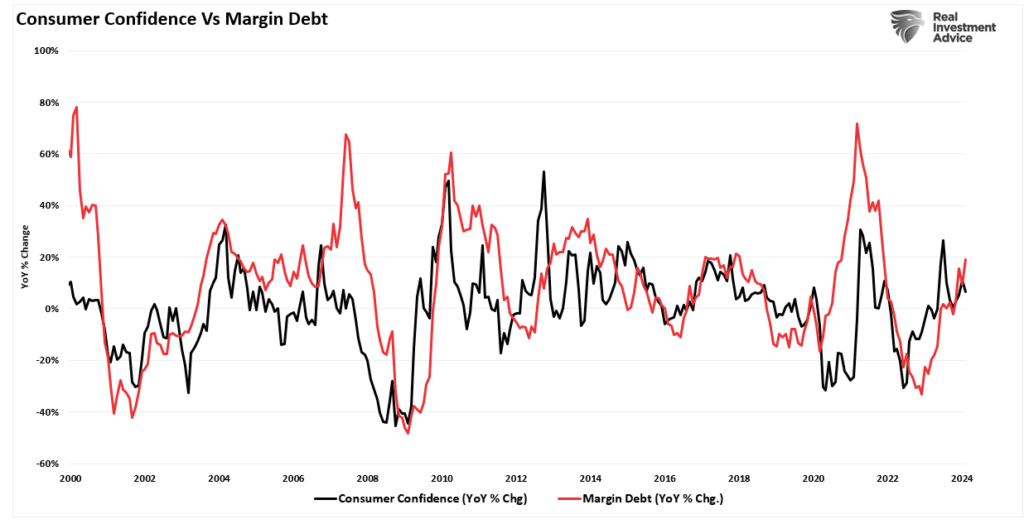
Adding to that exuberance is the increased demand for share repurchases, which has been a primary source of “buying” since 2000. As CEO confidence improves, a byproduct of increased consumer confidence, they increase the demand for share repurchases. As buybacks boost asset prices, investors take on more leverage and increase exposure as a virtual spiral develops.
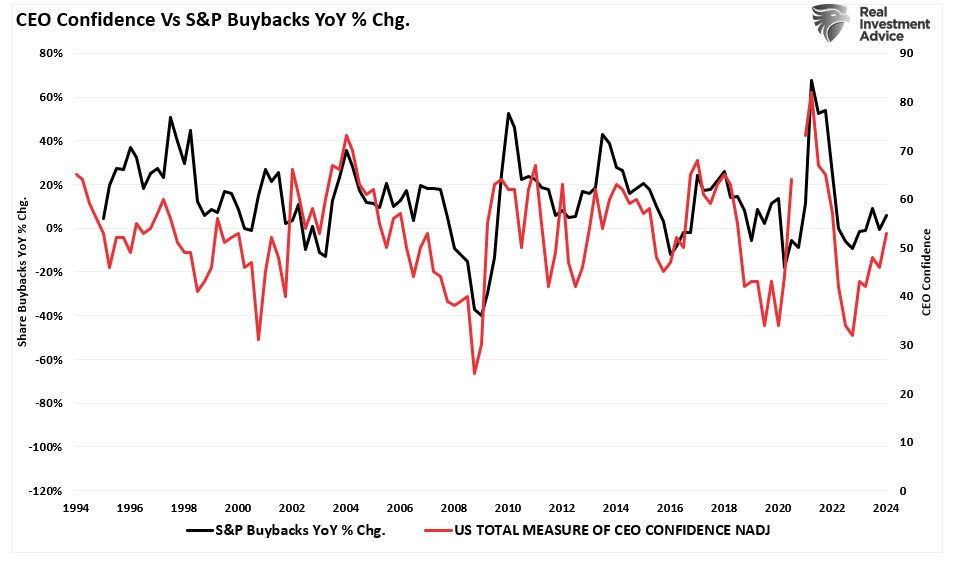
However, should investors be afraid of rising margin debt?

A Byproduct Of Exuberance
Before we dig further into what margin debt tells us, let’s begin with where we are currently. There is clear evidence that investors are once again highly exuberant. The “Fear Greed” index below differs from the CNN measure in that our model measures positioning in the market by how much professional and retail investors are exposed to equity risk. Currently, that exposure is at levels associated with investors being “all in” the equity “pool.”
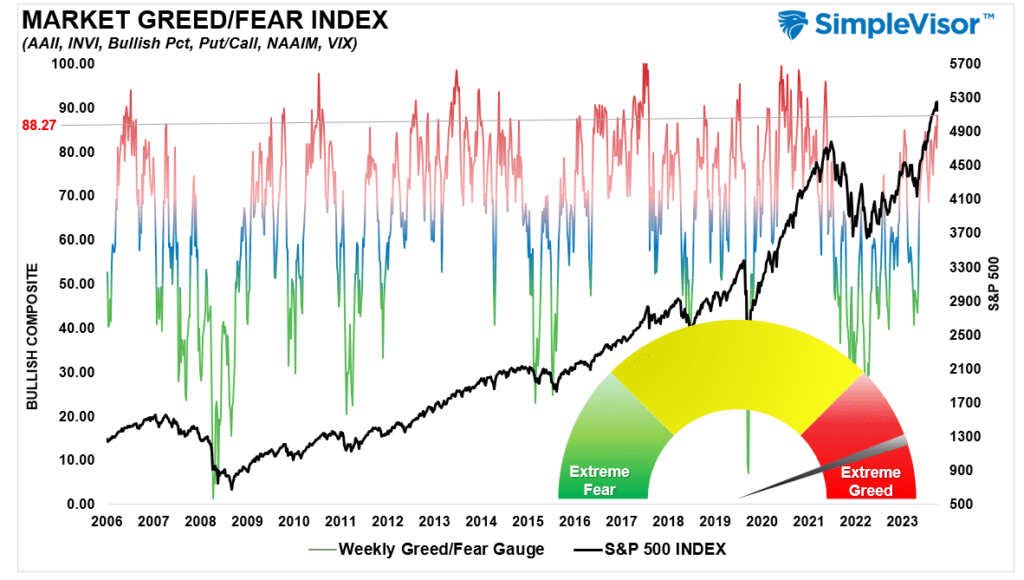
As Howard Marks noted in a December 2020 Bloomberg interview:
“Fear of missing out has taken over from the fear of losing money. If people are risk-tolerant and afraid of being out of the market, they buy aggressively, in which case you can’t find any bargains. That’s where we are now. That’s what the Fed engineered by putting rates at zero…we are back to where we were a year ago—uncertainty, prospective returns that are even lower than they were a year ago, and higher asset prices than a year ago. People are back to having to take on more risk to get return. At Oaktree, we are back to a cautious approach. This is not the kind of environment in which you would be buying with both hands.
The prospective returns are low on everything.”

Of course, in 2021, that market continued its low volatility grind higher as investors took on increasing margin debt levels to chase higher equities. However, this is the crucial point about margin debt.
Margin debt is not a technical indicator for trading markets. What it represents is the amount of speculation occurring in the market. In other words, margin debt is the “gasoline,” which drives markets higher as the leverage provides for the additional purchasing power of assets. However, leverage also works in reverse, as it supplies the accelerant for more significant declines as lenders “force” the sale of assets to cover credit lines without regard to the borrower’s position.
The last sentence is the most important. The issue with margin debt is that the unwinding of leverage is NOT at the investor’s discretion. That process is at the discretion of the broker-dealers that extended that leverage in the first place. (In other words, if you don’t sell to cover, the broker-dealer will do it for you.) When lenders fear they may not recoup their credit lines, they force the borrower to put in more cash or sell assets to cover the debt. The problem is that “margin calls” generally happen simultaneously, as falling asset prices impact all lenders simultaneously.
Margin debt is NOT an issue – until it is.
As shown, Howard was eventually right. In 2022, the decline wiped out all of the previous year’s gains and then some.
So, where are we currently?

Margin Debt Confirms The Exuberance
As noted, margin debt supports the advance when markets are rising and investors are taking on additional leverage to increase buying power. Therefore, the recent rise in margin debt is unsurprising as investor exuberance climbs. The chart shows the relationship between cash balances and the market. I have inverted free cash balances, so the relationship between increases in margin debt and the market is better represented. (Free cash balances are the difference between margin balances less cash and credit balances in margin accounts.)
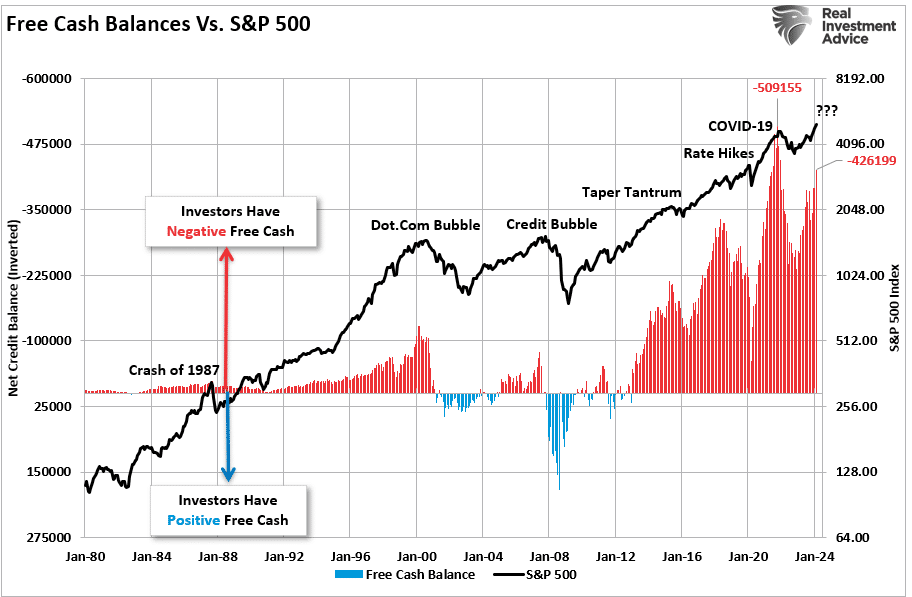
Note that during the 1987 correction, the 2015-2016 “Brexit/Taper Tantrum,” the 2018 “Rate Hike Mistake,” and the “COVID Dip,” the market never broke its uptrend, AND cash balances never turned positive. Both a break of the rising bullish trend and positive free cash balances were the 2000 and 2008 bear market hallmarks. With negative cash balances shy of another all-time high, the next downturn could be another “correction.” However, if, or when, the long-term bullish trend is broken, the unwinding of margin debt will add “fuel to the fire.”
While the immediate response to this analysis will be, “But Lance, margin debt isn’t as high as it was previously,” there are many differences between today and 2021. The lack of stimulus payments, zero interest rates, and $120 billion in monthly “Quantitative Easing” are just a few. However, some glaring similarities exist, including the surge in negative cash balances and extreme deviations from long-term means.
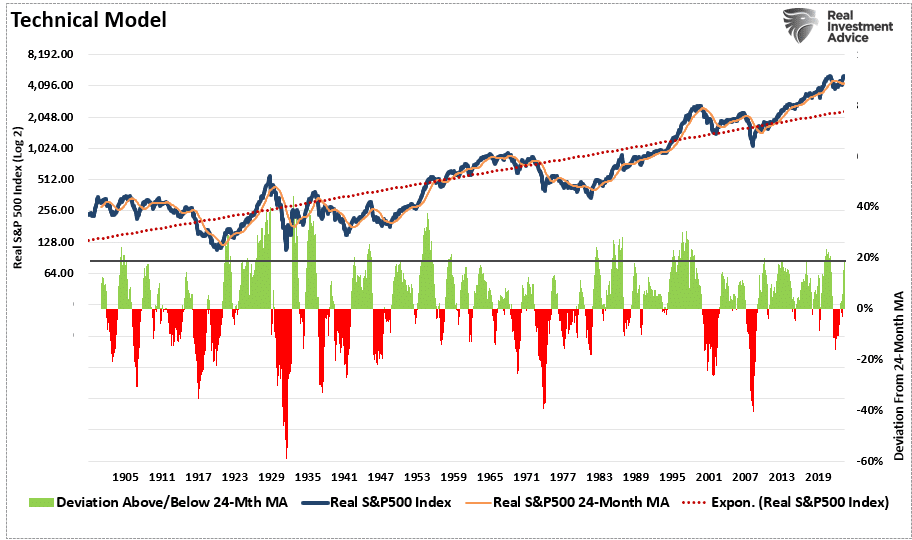
In the short term, exuberance is infectious. The more the market rallies, the more risk investors want to take on. The issue with margin debt is that when an event eventually occurs, it creates a rush to liquidate holdings. Since margin debt is a function of the value of the underlying “collateral,” the forced sale of assets will reduce the value of the collateral. The decline in value then triggers further margin calls, triggering more selling, forcing more margin calls, and so forth.
Margin debt levels, like valuations, are not useful as a market-timing device. However, they are a valuable indicator of market exuberance.
While it may “feel” like the market “just won’t go down,” it is worth remembering Warren Buffett’s sage words.
“The market is a lot like sex, it feels best at the end.”
The post Margin Debt Surges As Bulls Leverage Bets appeared first on RIA.
-
Site: Zero HedgeChina's Largest Funds Apply For Spot Bitcoin ETF In Hong KongTyler Durden Tue, 04/09/2024 - 05:45
Authored by Vivek Sen via BitcoinMagazine.com,
Some of China's biggest asset managers are using Hong Kong subsidiaries to enter the Bitcoin ETF market, according to recent reports.
Securities Times reported on Monday that financial giants like Harvest Fund and Southern Fund have submitted applications via their Hong Kong arms and are awaiting regulatory approval.
The move reflects growing institutional interest despite China's previous hostility towards Bitcoin.
Harvest Fund manages over $230 billion in total assets, while Southern Fund oversees over $280 billion.
Approval of Bitcoin ETF products from such influential institutions could significantly validate Bitcoin in the eyes of both Chinese regulators and investors.
The news is also a testament to the evolving landscape of Bitcoin in China. Despite its previous crackdown on Bitcoin trading and mining, the country is now witnessing a shift. While the mainland remains cautious, Hong Kong has adopted a more open approach, attracting the attention of Chinese funds.
By leveraging Hong Kong subsidiaries, major funds can gain exposure to Bitcoin in a compliant manner.
The location provides a legal loophole for Chinese companies to participate in the burgeoning Bitcoin asset class.
Industry insiders are buzzing with anticipation as they predict a significant milestone in Bitcoin.
Hong Kong's first Bitcoin ETFs could potentially launch as early as Q2 this year.
Financial leaders are clearly eager to meet surging investor demand for Bitcoin access.
Bitcoin ETFs offer a regulated on-ramp for both institutional and retail players.
-
Site: Crisis Magazine

Naturally the piece I recently wrote for Crisis, “Modern Catholic Recovery Conference,” provoked wildly different responses. Some who fully endorsed my expressions of distress at so many lamentable elements in the modern church were almost giddy with delight at my humorous proposals. Others misconstrued my purpose and thought I was mocking the TradRecovery conference in spite of the fact that I…
-
Site: Fr Hunwicke's Mutual EnrichmentThe Magdalene Laundries ... the treatment of Fallen Women ... what a cruel and depraved island Ireland was! Poor old De Valera ... Poor od Archbishop McQuaid ... what a corrupt, hate-filled society they ran!! Apologies ... Compensation ... but what good is all that? It is not much better than words.The Times recently published a review of a new book. The Reviewer asked: "How surprised would you Fr John Hunwickehttp://www.blogger.com/profile/17766211573399409633noreply@blogger.com0
-
Site: Crisis Magazine

“These are my people,” I thought to myself as I listened to the panel of speakers. Or at least as much as people I had never met could be. And I never did meet any of those speakers as it turns out. It was the last day of the “Symbolic World Summit,” in Tarpon Springs, Florida, held from February 29 to March 2. One of the panelists, a poet and raconteur named Martin Shaw, gave us all homework…
-
Site: Zero HedgeSaudi Arabia 'Scales Back' Goals Of Neom Megacity ProjectTyler Durden Tue, 04/09/2024 - 05:00
Saudi Arabia has scaled back some of its ambitions for its desert megacity Neom, according to a report by Bloomberg. The $1.5 trillion megacity project, which organizers claim will be 33 times the size of New York City, is due to include a 170km straight-line city.
When launching The Line in 2021, the Saudi government had announced that 1.5 million people would be living in the city by 2030. Officials now expect there to be fewer that 300,000 residents by that time, according to a source cited by Bloomberg.
 The design plan for the 500-meter tall parallel structures, known collectively as The Line, featured in a handout picture provided by Saudi's Neom, via AFP.
The design plan for the 500-meter tall parallel structures, known collectively as The Line, featured in a handout picture provided by Saudi's Neom, via AFP.
The source said that officials expected only 2.4km of the 170km city to be completed by 2030. As a result of the scaling back, one contractor dismissed some of the workers it employs on site, according to a document seen by Bloomberg.
Neom - part of Saudi Arabia's Vision 2030 strategy to diversify the economy and move away from oil reliance - is being built in the northwestern Tabuk province.
Middle East Eye reported last year that construction was under way on The Line, based on satellite imagery.
The Line is due to have no cars or roads, and a high-speed rail service running across the length of the city, Saudi Arabia's Crown Prince Mohammed bin Salman announced three years ago.
Two parallel, mirrored buildings that are nearly 500 meters tall and 120km wide are also planned as part of the project, according to designs uncovered in 2022.
In addition to the horizontal city, Neom is also touted to include an eight-sided city that floats on water, a ski resort with a folded vertical village, and a Red Sea luxury island resort called Sindalah. The Sindalah project is due to open later this year.
Sources told Bloomberg that work was continuing on other parts of the Neom project, and Saudi officials still backed the overall aims of The Line.
Official video previewing the ultra-ambitious Neom project...
Extended video "The Line" —Saudi's Neom Mega-City Project pic.twitter.com/9tFGIhBKdm
— VisionaryVoid (@VisionaryVoid) April 8, 2024The sources added that Saudi Arabia's Public Investment Fund, which is providing most of the funding for the project, has yet to confirm its 2024 budget for Neom.
The scaling back of the megacity project comes as the Public Investment Fund cash reserves dropped to $15bn in September, its lowest levels since 2020.
-
Site: AsiaNews.itToday's news: Record gold seizure at Hong Kong customs worth more than $10 million; For the Thai premier, it is time for talks with the coup junta in Myanmar, which is starting to 'lose strength';Beijing blocked a popular Tibetan-language blog;Meeting between the foreign ministries of Russia and China, Putin's visit to Xi Jinping on the agenda.
-
Site: RT - News
The platform is “by far” the best place online to correct untrue information, the entrepreneur has argued
The owner of X (formerly Twitter), Elon Musk, has rejected accusations that Russian misinformation was widespread on his platform.
The entrepreneur, who describes himself as a champion of free speech, has been accused of making the social network vulnerable to Russian activities by changing its content moderation protocols after purchasing Twitter in 2022.
His latest denial came on Tuesday, while he was discussing X on ‘In Good Company’, a podcast. Host Nicolai Tangen suggested that Russian activity via fake accounts was “huge” in Germany.
“We don’t see a lot of Russian activity, to be frank, on the system. We see very little,” Musk responded. “We do see a lot of attempts to influence things, but they seem to be coming from the West, not from Russia.”
Read more Biden denies proclaiming Transgender Day of Visibility on Easter Sunday
Biden denies proclaiming Transgender Day of Visibility on Easter Sunday
Tangen’s remark apparently referred to claims made by Berlin in January. The German government said that the use of specialized monitoring software had allowed it to identify an estimated 50,000 fake accounts engaged in a pro-Russian misinformation campaign on X. Local press claimed that the messaging was strikingly similar to that of the right-wing opposition party AfD.
Germany is not alone in its wariness regarding Moscow’s influence; this week US Congressman Mike Turner, who chairs the House Intelligence Committee, accused some fellow Republicans of repeating ‘Russian propaganda’ in the chamber.
“It is absolutely true we see, directly coming from Russia, attempts to mask communications that are anti-Ukraine and pro-Russia messages, some of which we even hear being uttered on the House floor,” the Ohio congressman told CNN’s Jake Tapper. Similar remarks came last week from House Foreign Affairs chair Michael McCaul, another Republican lawmaker.
In his interview, Musk hailed X as arguably “the best source of truth on the Internet” that, he argued, by far surpasses traditional news outlets in terms of accuracy thanks to user-driven fact-checking tools.
READ MORE: Musk defies Supreme Court judge’s order to block X accounts in Brazil
“A lot of people still run under the illusion that the legacy newspapers they read are actually true. There is so much nonsense in them,” he lamented.
-
Site: Zero HedgeJudge Reduces Roundup Verdict Against Bayer From $1.5 Billion To $550 MillionTyler Durden Tue, 04/09/2024 - 04:15
A judge in Missouri has significantly reduced a jury award against Bayer AG's Monsanto unit, cutting down the punitive damages from a $1.5 billion verdict to about $550 million, according to Fortune.
This decision comes amid Monsanto's ongoing legal battles over allegations that its Roundup weedkiller causes cancer. While the judge, Daniel Green, declined Monsanto's request for a new trial or to dismiss the verdict entirely, the reduction in damages provides some financial relief to Bayer.
The company, which acquired Monsanto for $63 billion in 2018, plans to appeal the entire verdict, arguing that the damages are still excessively high.
The original verdict awarded three plaintiffs a combined $61.1 million in actual damages and $500 million each in punitive damages for claims that Roundup use led to non-Hodgkin’s lymphoma.
The punitive damages were adjusted to align with Supreme Court guidance, which suggests punitive awards should not exceed 10 times the actual damages.
Fortune reported that Bayer has already allocated up to $16 billion to settle over 100,000 similar cases, and it's now facing a new wave of litigation.
The company has also committed to replacing glyphosate in its U.S. consumer Roundup products with other weed-killing ingredients. The Missouri case, involving plaintiffs from across the U.S., highlights the ongoing controversy and legal challenges surrounding Roundup and its alleged health risks.
“While the court reduced the unconstitutionally excessive damage award, the company believes that the court did not apply the law correctly on damages,” the company commented.
Jay Utley, a lawyer for the former Roundup users, added: “The judge actually agreed with the plaintiffs’ suggestion the punitive-damages amounts be reduced to nine times their actual damages.”
He concluded: “The awards align with the evidence of Monsanto’s willful, malicious, and reckless disregard for the safety of consumers and the injuries suffered by these plaintiffs.”
-
Site: AsiaNews.itAlso called 'the pearl of the Silk Road' Turkestan is one of the oldest cities in Central Asia. In recent times, the figure of the dervish Khwaja Ahmad Tasavi, an Islamic preacher and Sufi poet, whose mausoleum is the destination of large pilgrimages, has been re-evaluated. Today, it seeks to combine futurist dimensions with the legacy of the past.
-
Site: Fr. Z's BlogIn Rome the sun rose at 06:37 and it will set at 19:47. The Ave Maria should ring at 20:00. Today is a 4th class feria, so I celebrated a Votive Mass of the Holy Angels and offered it for … Read More →
-
Site: Mises Institute
-
Site: RT - News
Washington wants to ensure that Novatek’s Arctic LNG 2 project is “dead in the water,” the State Department has said
The US is aiming to halt the development of the Russian energy sector, including a major new LNG project in the Arctic, senior State Department official Geoffrey Pyatt has said.
Speaking at a Financial Times summit on Monday, Pyatt stated that the US is specifically targeting the Arctic LNG 2 project in Russia’s northern Yamal Region, which is being developed by private energy giant Novatek.
“Our goal is to ensure that Arctic LNG 2 is dead in the water,” Pyatt, who serves as assistant secretary of state for energy resources, was quoted as saying by the British newspaper. “We’re very focused on ensuring that Russia is not able to develop new projects in order to [redirect] the gas that it had previously sent into Europe.”
The US has imposed several rounds of economic restrictions on Arctic LNG 2, the most recent of which was announced in November 2023.
Cutting Europe off from cheap Russian pipeline gas has been a key component of Western retaliation since Moscow launched its military operation in Ukraine in 2022. While American LNG producers have seized a large share of the market, Russian gas continues to flow to some EU member states.
According to a Reuters estimate, the EU boosted purchases of Russian LNG in 2023 to compensate for the loss of pipeline gas. LNG currently holds a 15% share of the market, up from roughly 8% before 2022. The share of the Russian pipeline gas was previously 37%.
READ MORE: EU boosts gas purchases from Russia – Reuters
Moscow considers the Ukraine conflict to be part of a US-led proxy war against Russia, one of the goals of which is to quash economic competition. The wellbeing of Europeans has been sacrificed by Washington in the process, Russian officials have argued.
The loss of the European market has prompted Moscow to refocus on pipelines linking major gas fields with customers in Asia, primarily China.
-
Site: Zero HedgeMore Russian LNG Being Exported To Europe Than AsiaTyler Durden Tue, 04/09/2024 - 03:30
By Charles Kennedy of OilPrice.com,
Russia’s liquefied natural gas (LNG) exports gained over 4% in the first quarter of this year as it increased output to replace sanctioned pipeline gas exports to Europe, Russia’s Kommersant newspaper reported on Monday.
Citing a 4.3% (8.7 million metric ton) increase in unsanctioned LNG exports in Q1 2024 based on data from Kpler, Kommersant.ru said exports to the European Union were rising, while those to Asia were declining. Russia’s LNG exports to Asia for the first quarter of the year saw a 7% decline, which was made up for by a 4% increase in exports to Europe, which received some 5 million tons of Russian LNG during that time period. The bulk of LNG production in Russia comes from the Yamal LNG project, run by Novatak, and the Sakhalin Energy project, run by Gazprom.
In late March, Moscow moved to sell Shell’s minority stake in the Sakhalin LNG project to state-run Gazprom for $1 billion. Initially, Moscow was planning to give the stake to Novatek in the wake of Shell’s move to abandon the project after Western regimes sanctioned Russia for its invasion of Ukraine. According to Russian newspaper Vedomosti, Novatek has deemed its participation in the Sakhalin project to have high legal risks.
The new data showing the rise in Russian LNG exports to the European Union indicates that Europe has replaced piped Russian gas from its eastern ports with Russian LNG at its western ports as the bloc becomes the biggest buyer of Russian LNG, clocking in half of all Russian LNG export volume this year so far, followed by China, which scooped up 21% as of February data.
Reuters data analysis in February also showed that the EU has replaced Russian piped gas flows with Russian LNG imported primarily to Spain, Belgium and France.
-
Site: Mundabor's blogI have tried to read the newest excrementation, or declaration, or whatever document it is, about the alleged infinite dignity of the human person. They quote the United Nation at the very start. I have stopped reading there, as I am not a follower of the United Nations religion. Still, already from a general perspective, […]
-
Site: Voltaire NetworkAtomic war is possible. World peace hangs on the finger of the United States, blackmailed by Ukrainian "integral nationalists" and Israeli "revisionist Zionists". If Washington doesn't deliver weapons to massacre the Russians and Gazans, they won't hesitate to launch Armageddon.
-
Site: AsiaNews.itPremier Srettha Thavisin presented the idea to counterparts from Cambodia, Laos, Malaysia, Myanmar and Vietnam. It is a move aimed at expanding the flow of visitors to the various countries and to feed the industry's revenues. However, for some experts it would be less streamlined because it requires more coordination in approvals.



